Laminated Steels - General Information and Specific Repair Procedures for Front Lower Rail replacement, Front Wheelhouse Replacement and Hinge Pillar Body Replacement

| Subject: | Laminated Steels - General Information and Specific Repair Procedures for Front Lower Rail Replacement, Front Wheelhouse Replacment and Hinge Pillar Body Replacement |
| Models: | 2005-2006 Chevrolet Malibu, Malibu Maxx |
| 2005-2006 Pontiac G6 |
| Built After May 22, 2005 |
Laminated steel consists of three layers of material: two layers of mild steel with a layer of "visco-elastic" material between them. This "sandwich" of material layers provides better sound absorbing properties than regular, non-laminated materials.
Laminated steel is being used on the 2005-2006 Chevrolet Malibu/Maxx and Pontiac G6 to enhance the acoustic performance. Currently the front dash panel is made from laminated steel.
This material is very different than standard steel applications. Because of these differences, it requires different repair procedures to be used when replacing components that attach directly to the laminated steel surfaces. Those components are typically structural rails, front wheelhouse/shock towers and front body hinge pillar inner panels. Depending on the design and build of the vehicle, though, some of the components may not attach directly to the laminated steel surface. Components that do not attach directly to the laminated steel surface may be attached in the normal manner.
General Repairability Guidelines
| • | MIG welding of this material is not recommended due to contamination of the weld from the "visco-elastic" layer. |
| • | Rivet/bonding of components that attach to laminated steel surfaces is recommended. This process uses a structural rivet combined with metal panel bonding adhesives currently recommended by GM that meet the performance requirements of GM 6449G (guidelines for adhesive manufacturers to develop metal panel bonding adhesives). |
| • | Resistance spot welding is recommended where the plier or jaw openings and reach of the tool will allow. Refer to the GM Dealer Equipment Catalog for current recommendations of resistance spot welding equipment or call 1-800-GMTOOLS. |
| • | Laminated steel can be straightened cold or with heat. If heat is required, temperatures should be controlled to less than 1,200 degrees and the duration of the heat should be kept to less than 3 minutes overall (it is preferable that this be done in multiple steps). Heating this material following these guidelines will not effect the acoustical performance of this material. |
Refer to GM Service Information for the 2005-2006 Chevrolet Malibu/Maxx and Pontiac G6 for specific procedures related to the components that attach to laminated steels. The procedures below have recently been added to SI. Additional procedures are currently being developed and Service Manual Update bulletins will be published to inform dealers of this new information.
Rail Replacement Front Compartment - Front (Laminated Steel Dash)
Removal Procedure
Caution: Refer to Approved Equipment for Collision Repair Caution.
Caution: Refer to Foam Sound Deadeners Caution.

Important:
• Model year 2005 and prior vehicles are not manufactured with laminated steel in front of the dashes. Therefore the front lower rail can be MIG welded instead of the rivet and bonding process as stated in these instructions. • Failure to follow this procedure will compromise the structural integrity of the vehicle.
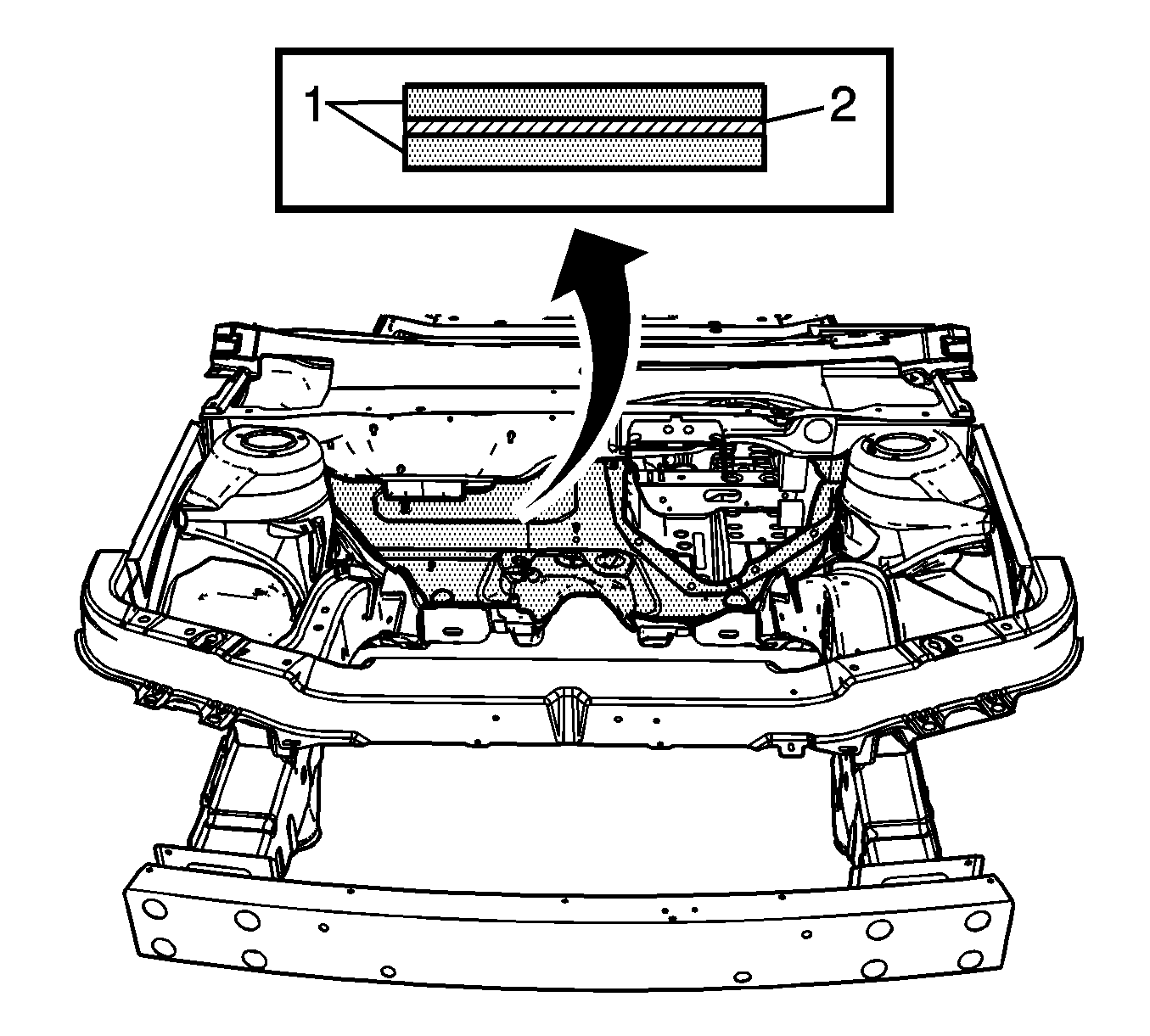
Important: The front of the dash panel is formed from laminated steel. This steel is constructed by bonding 2 pieces of cold rolled steel (1) with a viscoelastic layer of adhesive (2). Metal inert gas (MIG) welding laminated steel does not meet GM Corporate standards for structural integrity. As an alternative, all factory welds will be replaced by using the rivet and adhesive bond method described in the installation portion of this procedure. The rivet and adhesive bond method must only be used in the areas as described in this procedure.
- Disable the SIR system. Refer to SIR Disabling and Enabling Zones.
- Disconnect the negative battery cable. Refer to Battery Negative Cable Disconnect/Connect Procedure.
- Remove all related panels and components.
- Repair as much of the damage as possible.
- Remove the sealers and the anti-corrosion materials from the repair area, as necessary. Refer to Anti--Corrosion Treatment and Repair.
- Note the number and location of the factory welds for installation of the full rail service part.
- Using an 8-mm (5/16-in) spot weld remover, locate and drill out the factory welds on the weld flange connecting the lower rail to the dash panel.
- From the passenger compartment, locate and drill out the remaining factory weld.
- Remove the full rail.
Caution: Refer to Collision Sectioning Caution.

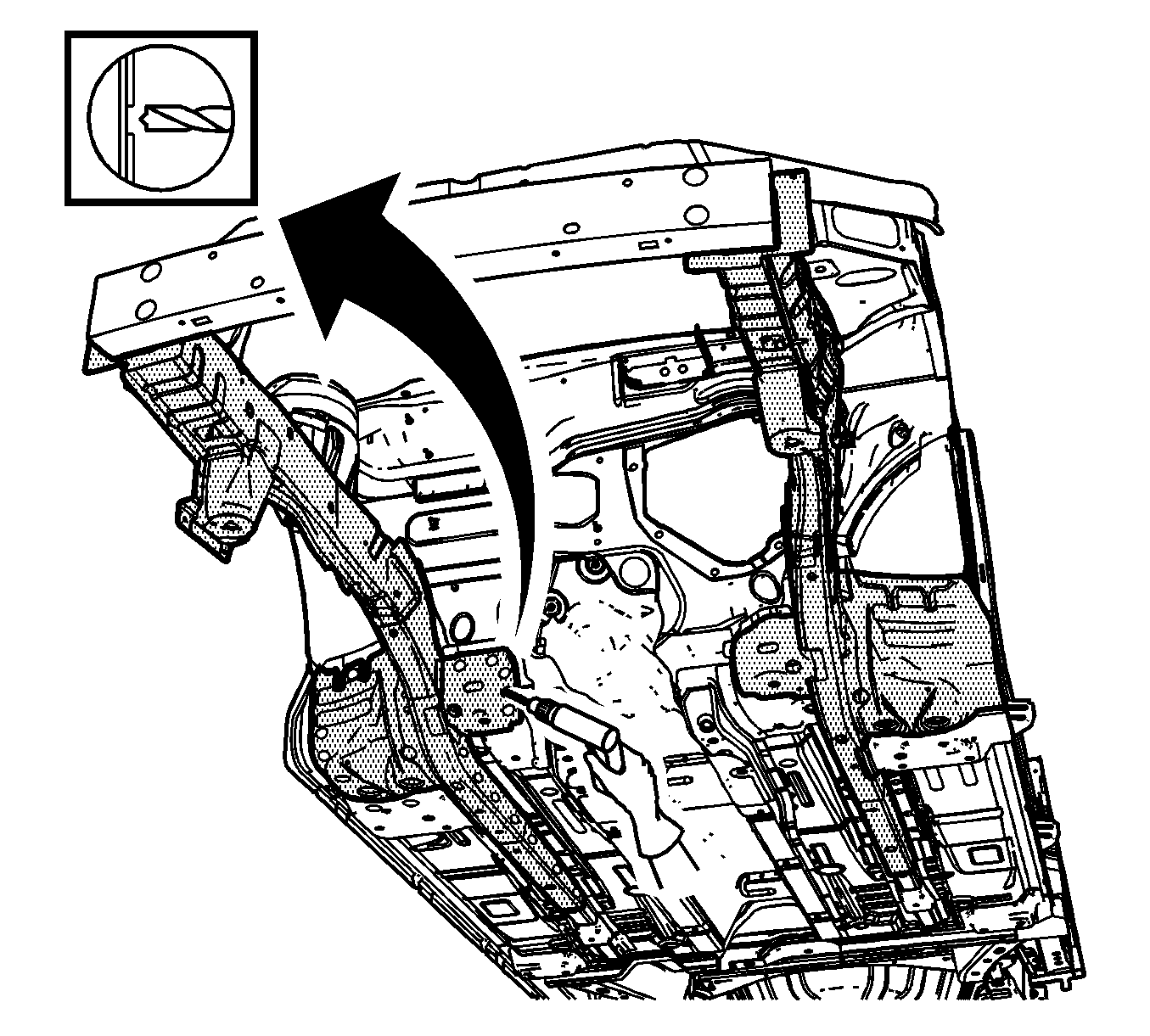
Important: Drill through the rail flange only. Do NOT drill into the dash panel or the inner reinforcements.

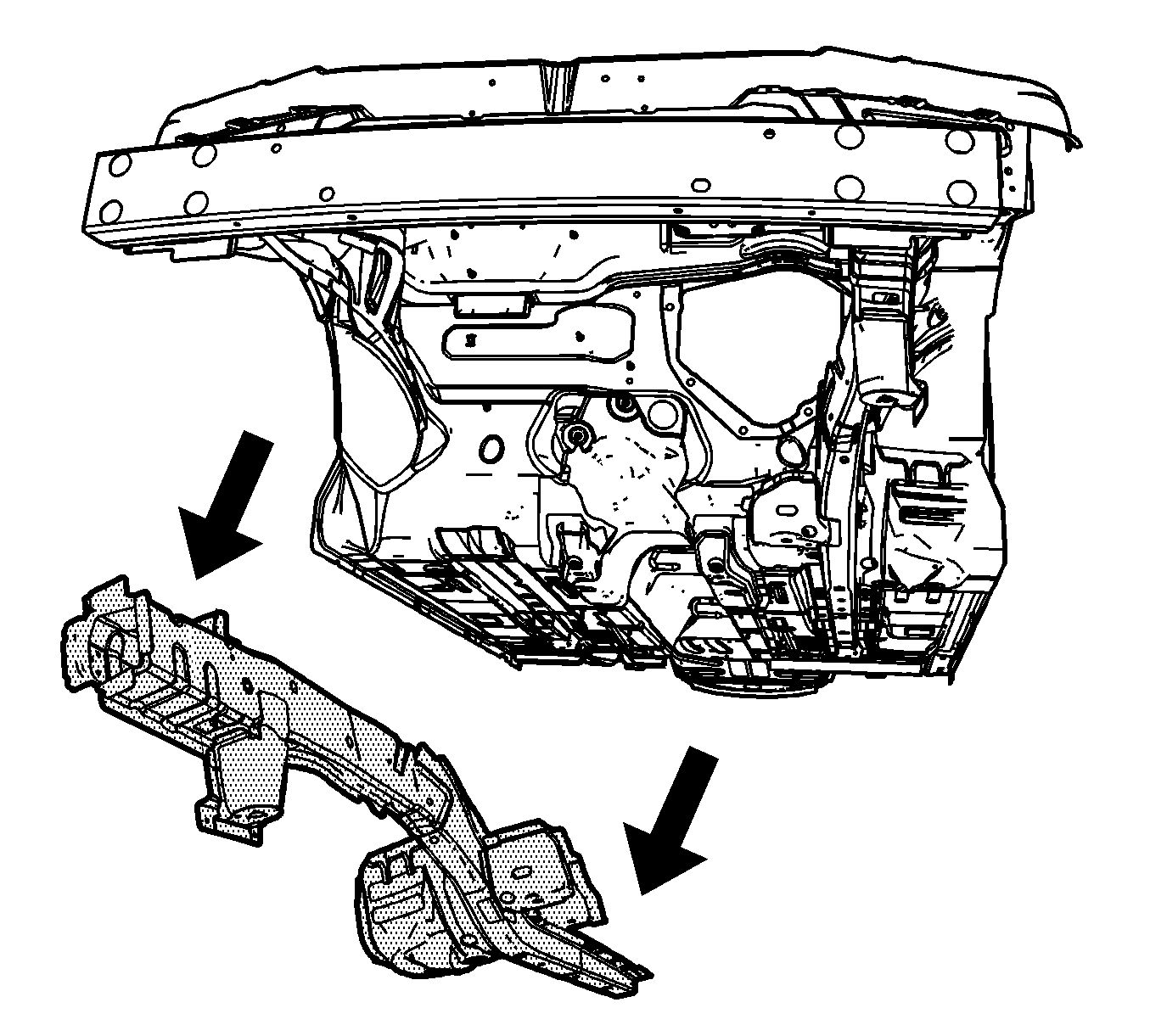
Installation Procedure
- Drill 8-mm (5/16-in) plug weld holes in the service front lower rail in the location noted from the original rail.
- Prepare the plug weld mating surfaces, as necessary.
- Apply 3M® Weld-Thru Coating, P/N 05913, or equivalent, to the plug weld mating surfaces.
- Position the service rail to the vehicle using three-dimensional measuring equipment.
- Clamp the rail in place.
- Using a 7-mm (17/64-in) bit, drill the rivet attachment holes through the service rail and the dash panel in the exact locations as noted from the factory rail.
- Remove the service rail.
- Prepare the plug weld mating surfaces, as necessary.
- Apply 3M® Weld-Thru Coating, P/N 05913, or equivalen,t to the plug weld mating surfaces.
- Prepare the bond mating areas by grinding the body mating and the service part flanges to bare steel. Do NOT damage the corners or thin the metal during the grinding process.
- Clean the mating surfaces.
- Apply a 3-6 mm (1/8 to 1/4 in) bead of metal panel bonding adhesive, GM P/N 12378567 (Canadian P/N 88901675), or equivalent, to both of the mating surfaces.
- Using a small acid brush, spread a coat of adhesive to both of the mating surfaces. Cover all of the bare metal to ensure corrosion protection.
- Apply a 3-6 mm (1/8 to 1/4 in) bead of metal panel bonding adhesive, GM P/N 12378567 (Canadian P/N 88901675), or equivalent, to the mating surface of the service rail.
- Position the service rail to the vehicle using three-dimensional measuring equipment.
- Clamp the rail in place.
- Install the 9 mm (11/32 in) long rivets so that the rivet head contacts the passenger compartment side of the dash.
- Install the 14-mm (17/32-in) long rivet so that the rivet head contacts the passenger compartment side of the dash, extending through the front rail and through the rail side extension.
- Remove the excess adhesive from the rail area.
- Plug weld the remaining holes accordingly.
- Clean and prepare all of the welded surfaces.
- Install the front wheelhouse assembly. Refer to Wheelhouse Replacement - Front.
- Install the radiator support assembly. Refer to Rail Replacement - Upper.
- Apply the sealers and anti-corrosion materials to the repaired area, as necessary. Refer to Anti--Corrosion Treatment and Repair.
- Paint the repaired area. Refer to Basecoat/Clearcoat Paint Systems.
- Install all of the related panels and components.
- Connect the negative battery cable. Refer to Battery Negative Cable Disconnect/Connect Procedure.
- Enable the SIR system. Refer to SIR Disabling and Enabling Zones.
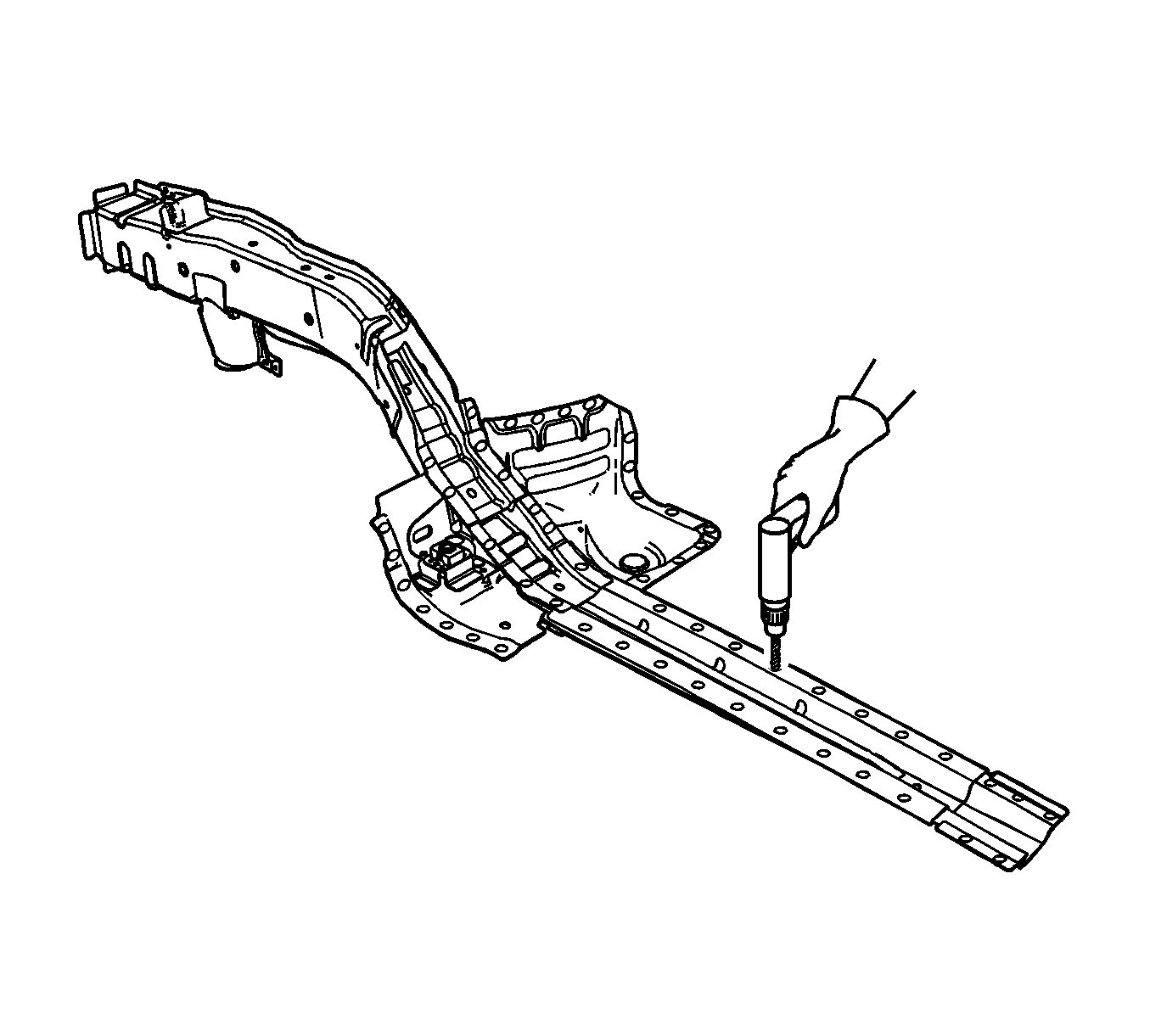
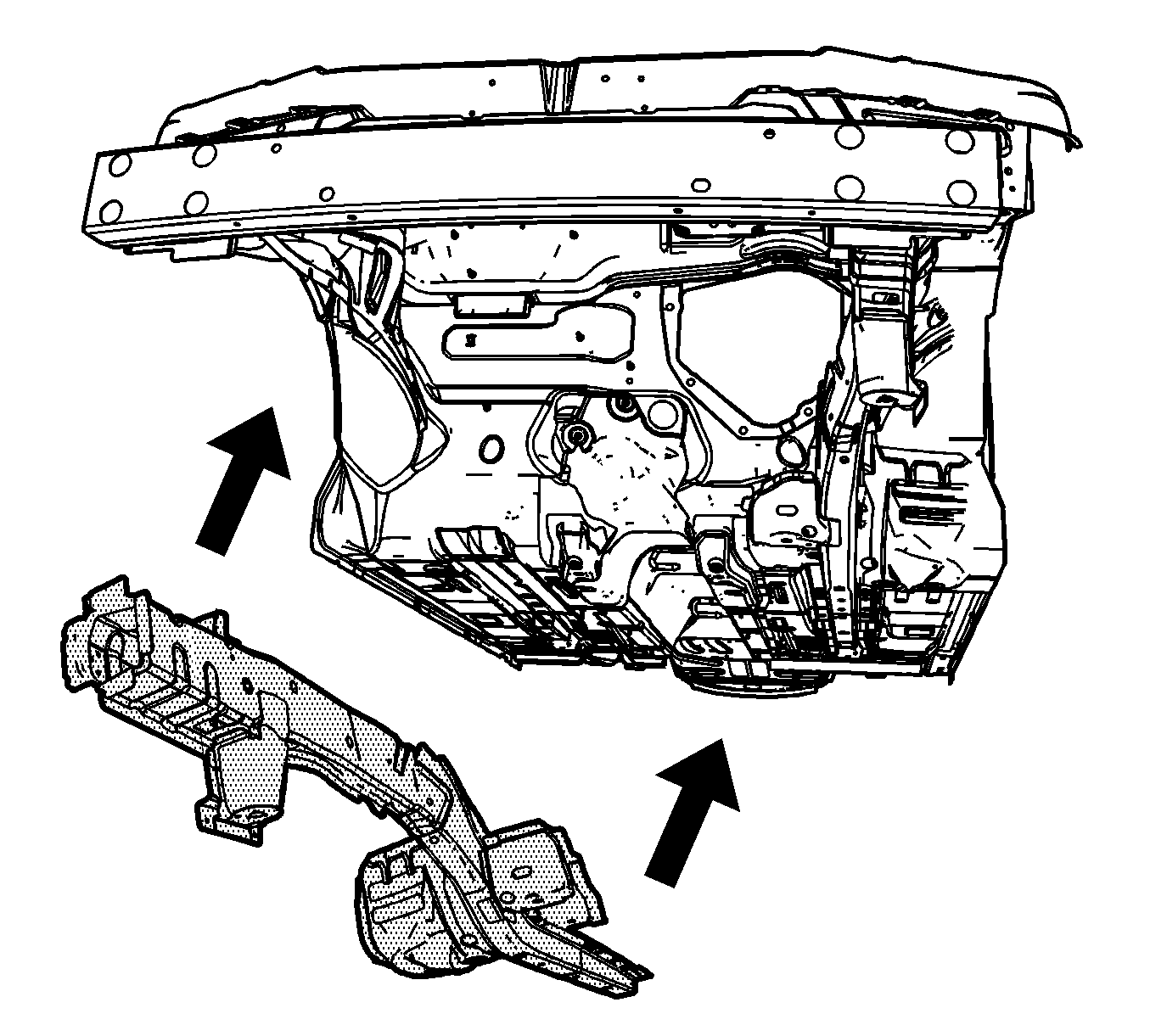

Important: If the location of the original plug weld holes cannot be determined, space the plug weld holes every 40 mm (1.5 in) apart.
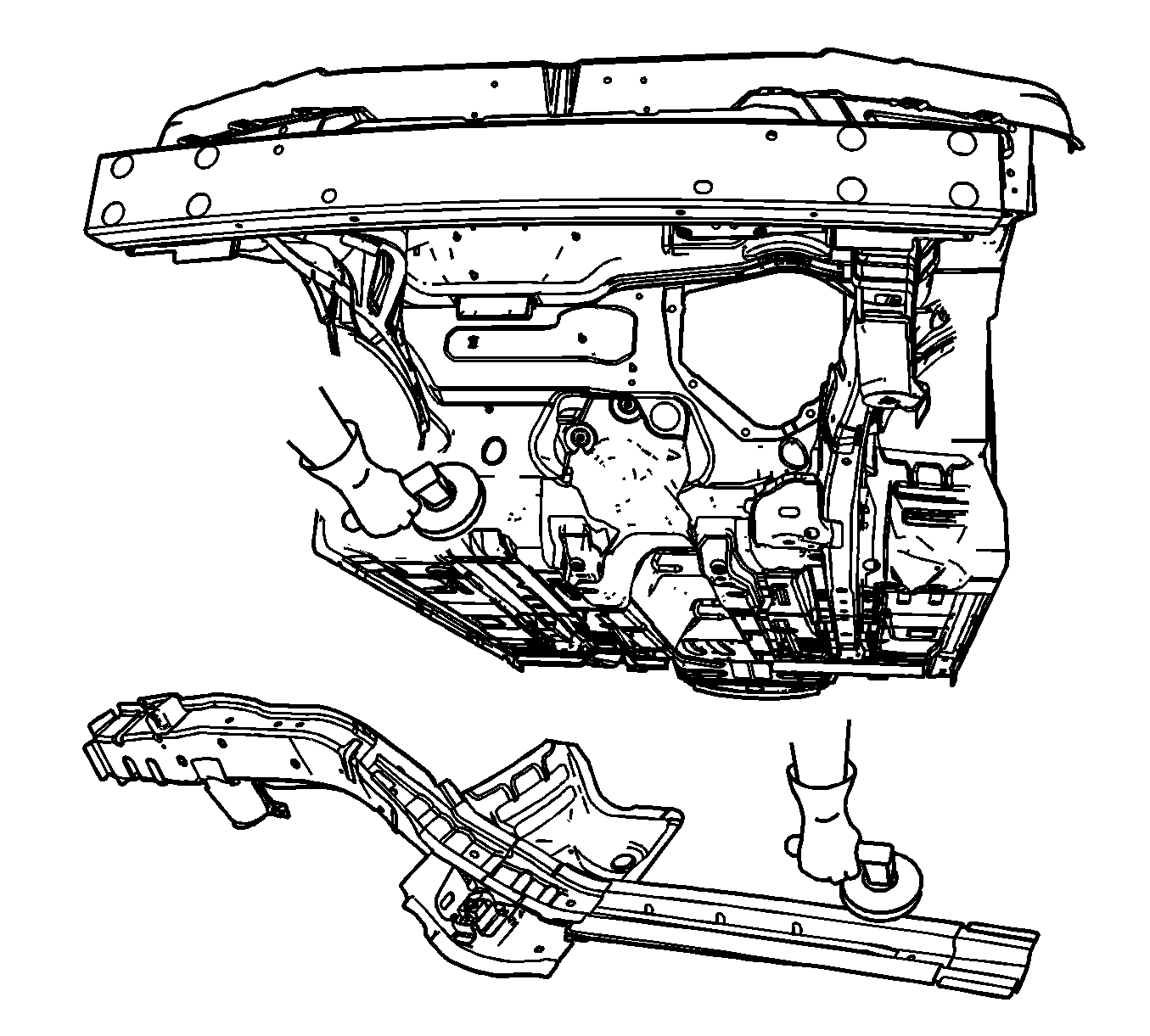
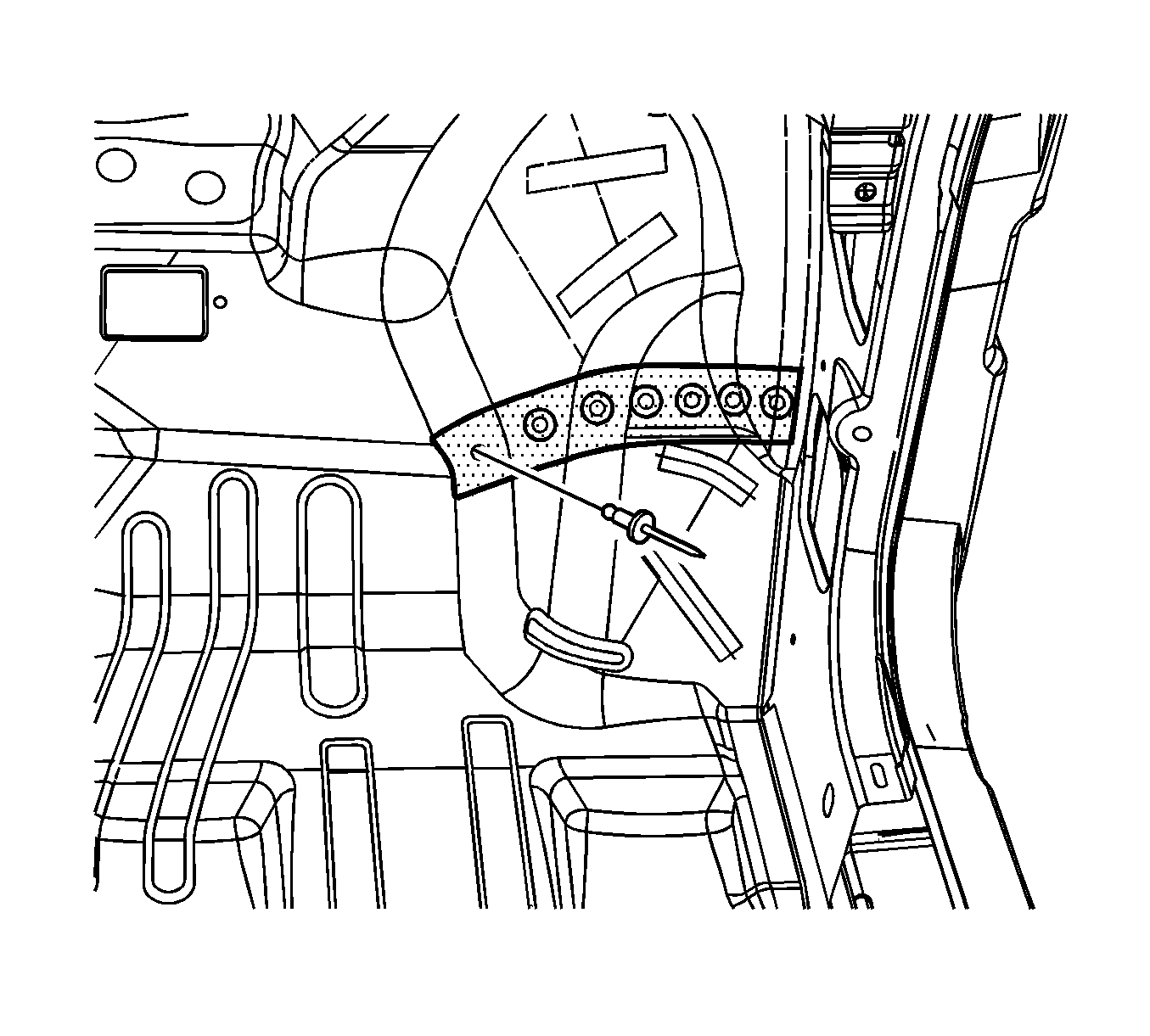
Important:
• Do NOT allow the adhesive to cure prior to installation of the front rail side extension. • Note the necessary location for installation of a 14-mm (17/32-in) long rivet.

Important: The adhesive has a 40-50 minute working time. Do NOT allow the adhesive to cure prior to installing the service rail.
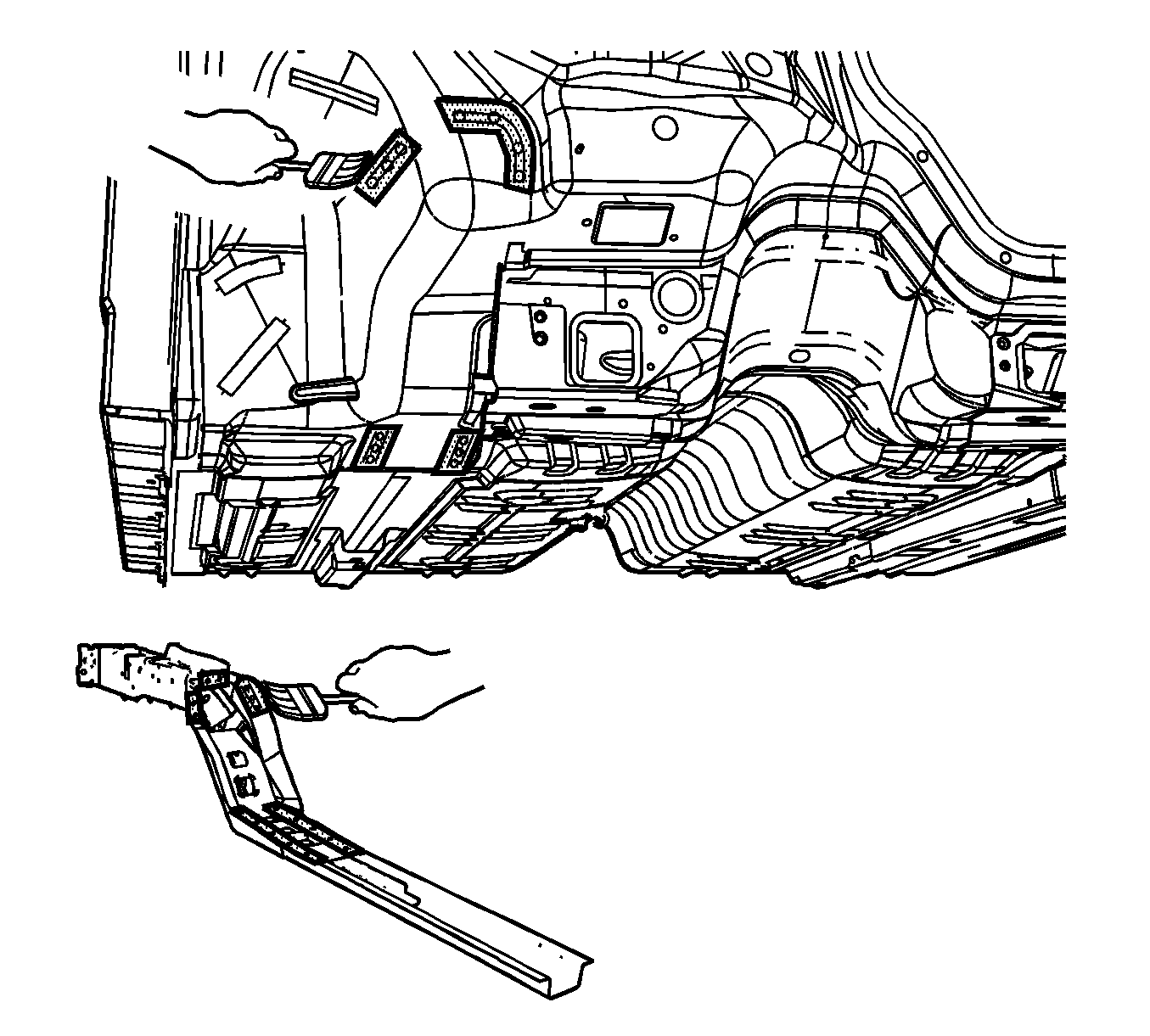
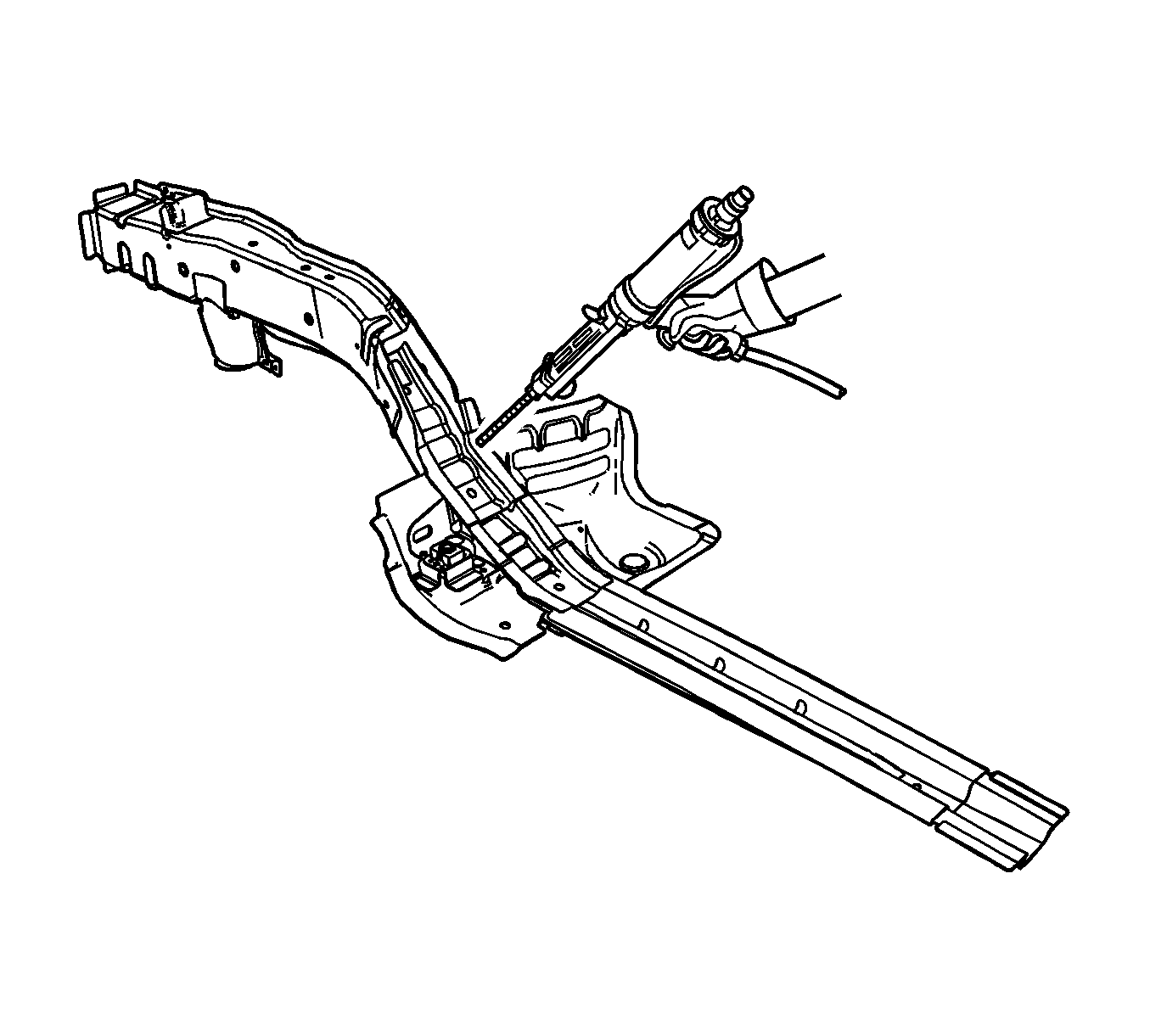

Important: Do NOT pull the rail off of the dash after adhesion. To align the parts, slide the rail against the front of the dash.
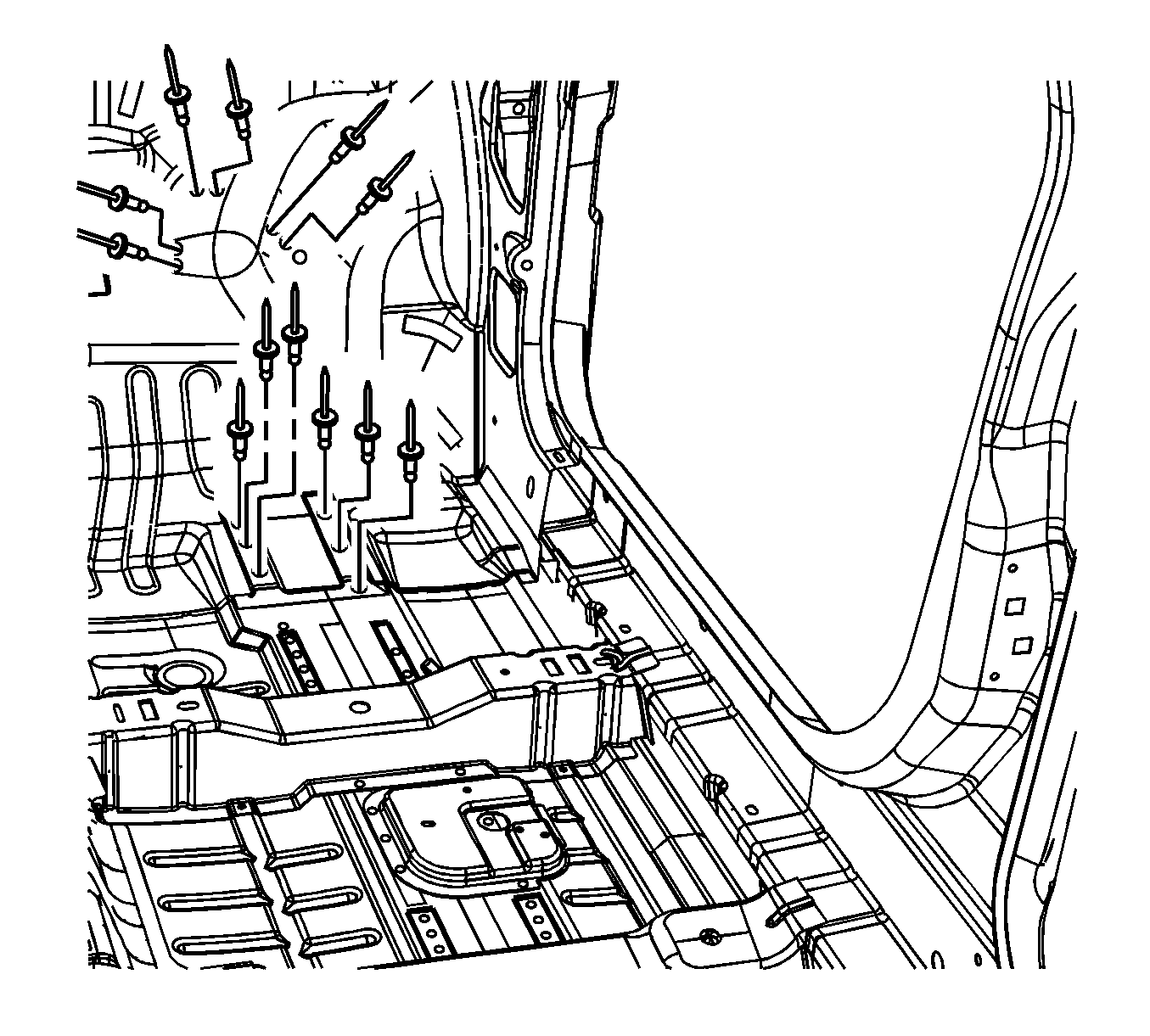
Important: Verify proper positioning of the service rail prior to riveting and welding.

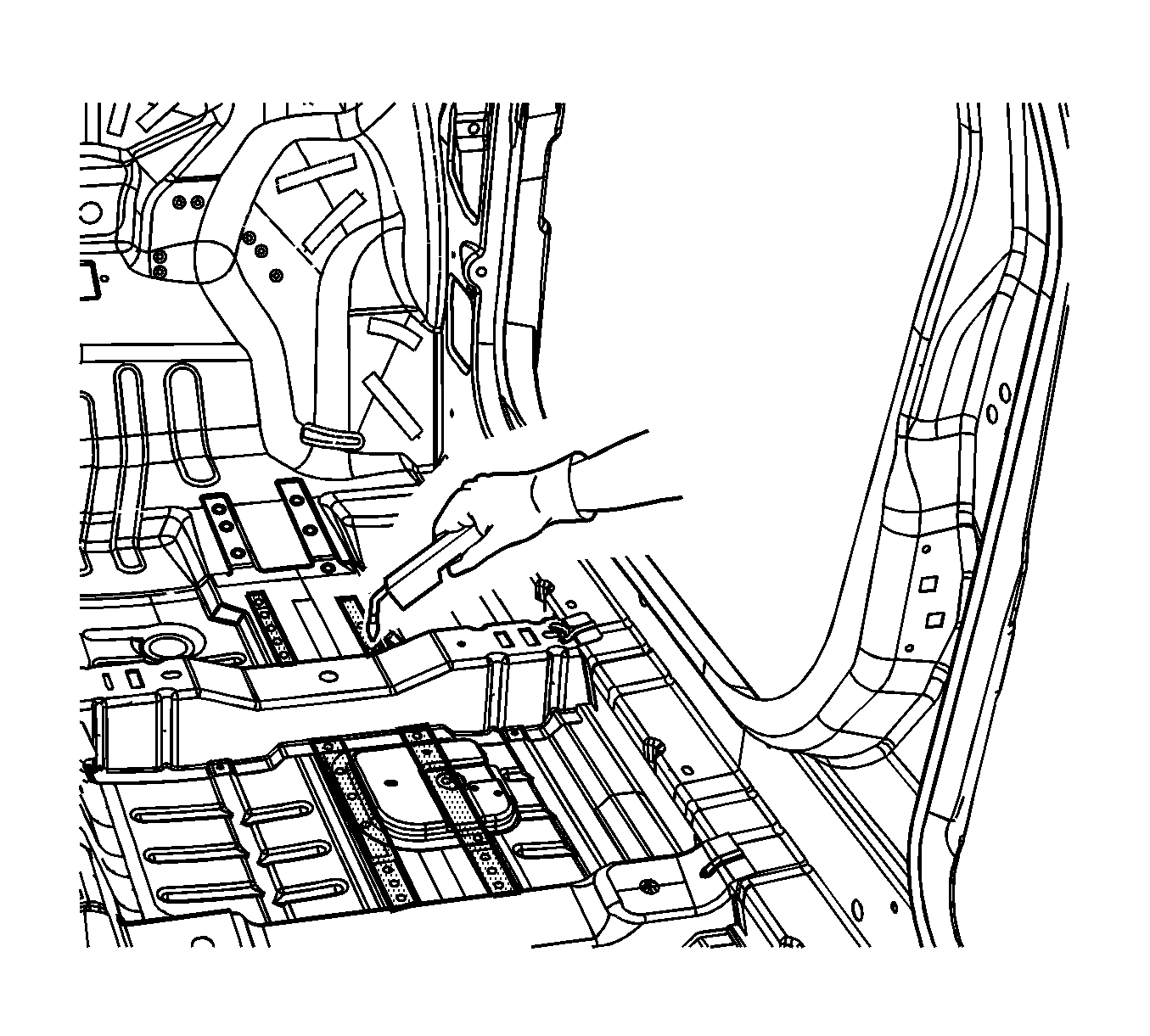
Wheelhouse Replacement - Front (Laminated Steel Dash)
Removal Procedure
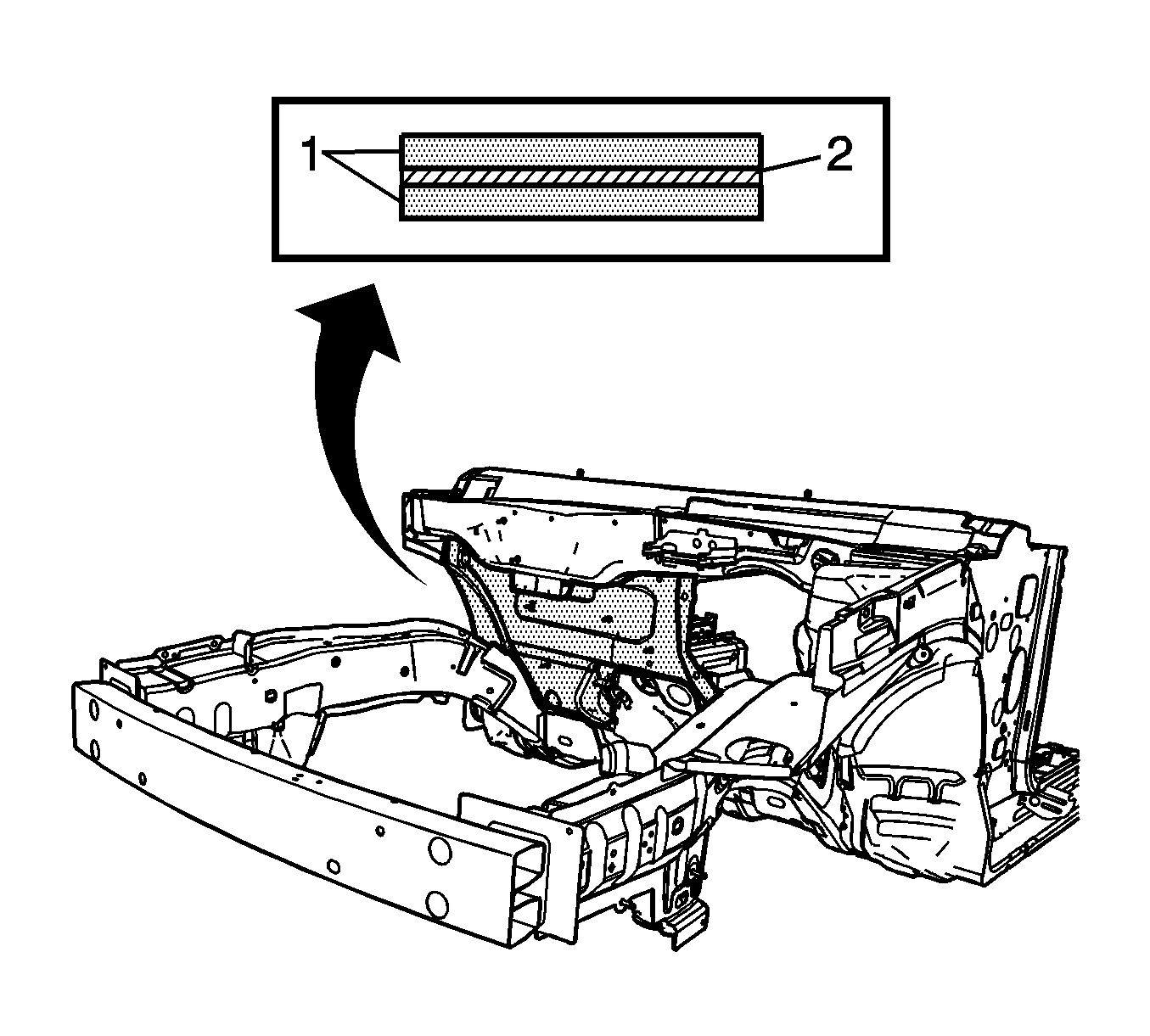
Caution: Refer to Approved Equipment for Collision Repair Caution.
Caution: Refer to Foam Sound Deadeners Caution.
Important:
• Model year 2005 and prior vehicles are not manufactured with laminated steel in front of the dashes. Therefore, the front wheelhouse assembly can be metal inert gas (MIG) welded instead of the rivet and bonding process, as stated in these instructions. The front of the dash panel is formed from laminated steel. This steel is constructed by bonding 2 pieces of cold rolled steel (1) with a viscoelastic layer of adhesive (2). MIG welding laminated steel does not meet GM Corporate
standards for structural integrity. As an alternative, all factory welds will be replaced by using the rivet and adhesive bond method described in the installation portion of this procedure. The rivet and adhesive bond method must only be used in the areas,
as described in this procedure. • Failure to follow this procedure will compromise the structural integrity of the vehicle.
- Disable the SIR system. Refer to SIR Disabling and Enabling Zones.
- Disconnect the negative battery cable. Refer to Battery Negative Cable Disconnect/Connect Procedure.
- Remove all related panels and components.
- Repair as much of the damage as possible.
- Remove the sealers and the anti-corrosion materials from the repair area, as necessary. Refer to Anti-Corrosion Treatment and Repair.
- Remove the radiator support assembly. Refer to Radiator Support Replacement.
- Remove the upper fender rail. Refer to Rail Replacement - Upper.
- Using an 8-mm (5/16-in) spot weld remover, locate and drill out the factory welds on the weld flange connecting the wheelhouse to the dash panel.
- Remove the wheelhouse.
Caution: Refer to Collision Sectioning Caution.
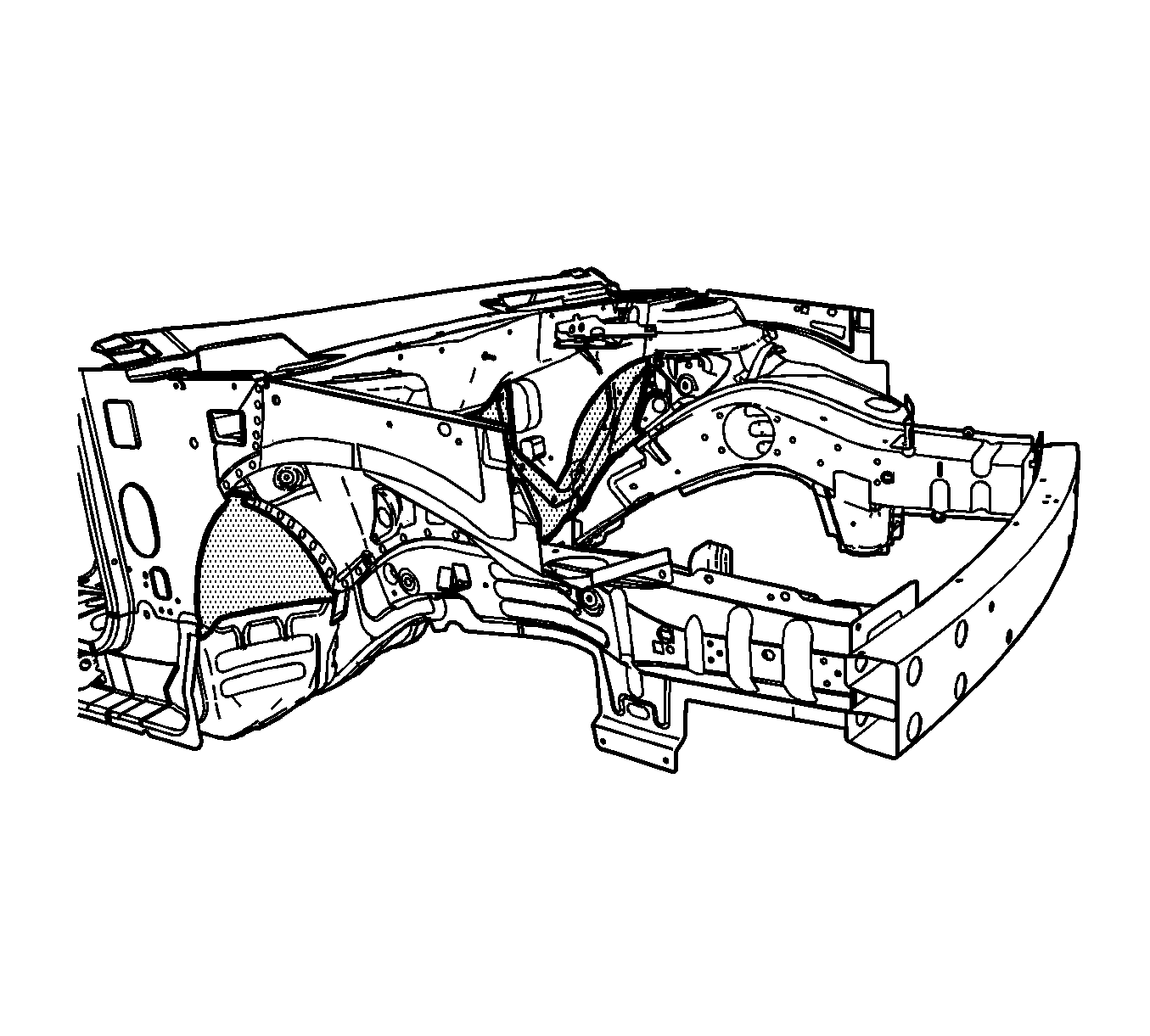
Important: Note the number and location of the factory welds for installation of the full wheelhouse service part.
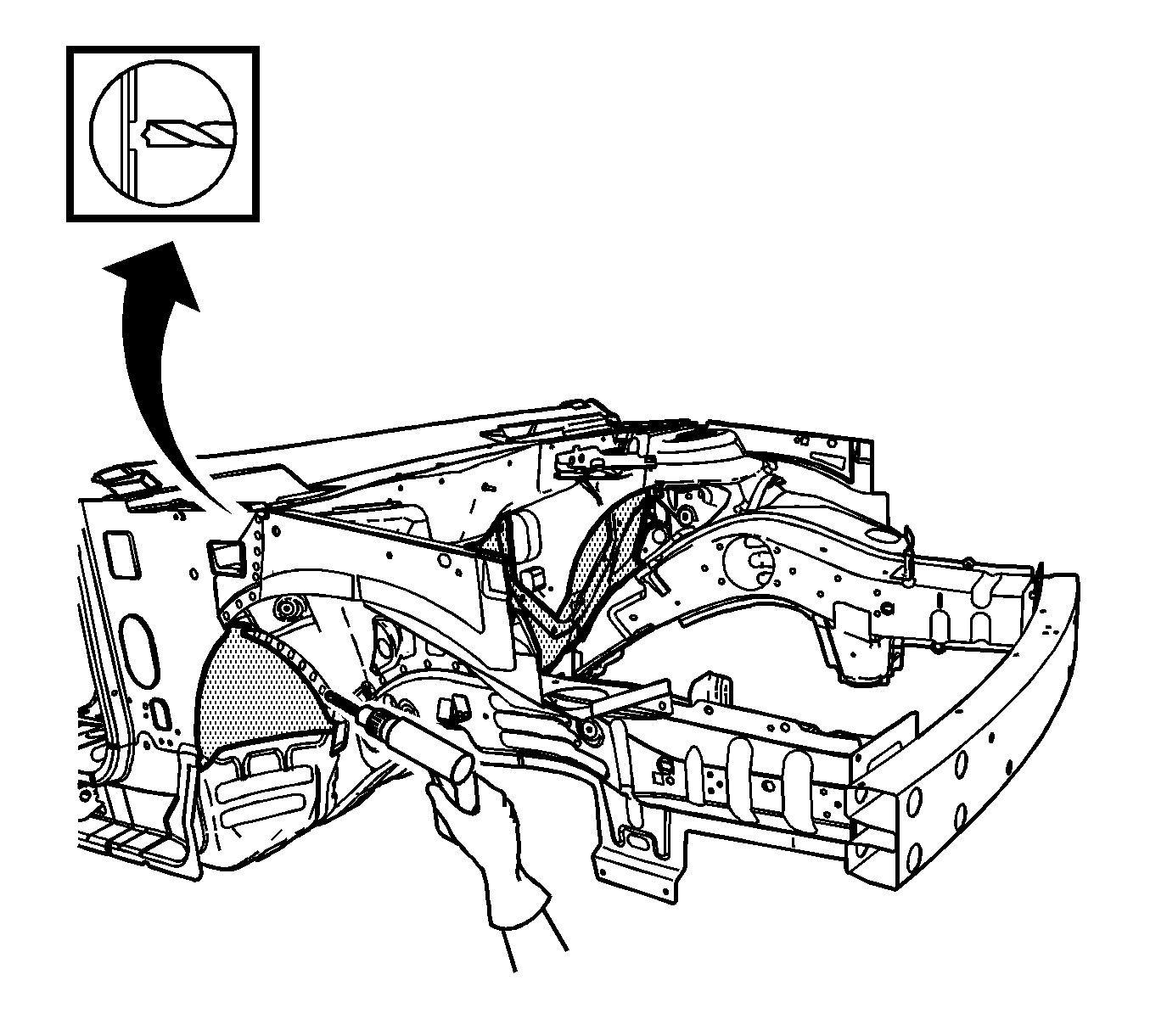
Important: Drill through the wheelhouse flange only. Do NOT drill into the dash panel or the inner reinforcements.

Installation Procedure
- Position the service wheelhouse to the vehicle using 3-dimensional measuring equipment.
- Clamp the wheelhouse in place.
- Using a 7-mm (17/64-in) bit, drill the rivet attachment holes through the service wheelhouse and the dash panel, in the exact locations as noted from the factory wheelhouse.
- Remove the service wheelhouse.
- Drill 8-mm (5/16-in) plug weld holes in the service wheelhouse, as necessary, in the remaining locations noted from the original wheelhouse.
- Prepare the plug weld mating surfaces, as necessary.
- Apply 3M® Weld-Thru Coating, P/N 05913, or equivalent, to the plug weld mating surfaces.
- Prepare the bond mating areas by grinding the body mating and the service part flanges to bare steel. Do NOT damage the corners or thin the metal during the grinding process.
- Clean the mating surfaces.
- Apply a 3-6 mm (1/8 to 1/4 in) bead of metal panel bonding adhesive, GM P/N 12378567 (Canadian P/N 88901675), or equivalent, to both of the mating surfaces.
- Using a small acid brush, spread a coat of adhesive to both of the mating surfaces. Cover all of the bare metal to ensure corrosion protection.
- Apply a 3-6 mm (1/8 to 1/4 in) bead of metal panel bonding adhesive, GM P/N 12378567 (Canadian P/N 88901675, or equivalent, to the mating surface of the service wheelhouse.
- Position the service wheelhouse to the vehicle using 3-dimensional measuring equipment.
- Clamp the wheelhouse in place.
- Install the 9 mm (11/32 in) long rivets so that the rivet head contacts the passenger compartment side of the dash.
- Remove the excess adhesive from the wheelhouse area.
- Plug weld the remaining holes accordingly.
- Clean and prepare all of the welded surfaces.
- Install the radiator support assembly. Refer to Radiator Support Replacement.
- Install the upper fender rail. Refer to Rail Replacement - Upper.
- Apply the sealers and anti-corrosion materials to the repaired area, as necessary. Refer to Anti-Corrosion Treatment and Repair.
- Paint the repaired area. Refer to Basecoat/Clearcoat Paint Systems.
- Install all of the related panels and components.
- Connect the negative battery cable. Refer to Battery Negative Cable Disconnect/Connect Procedure.
- Enable the SIR system. Refer to SIR Disabling and Enabling Zones.

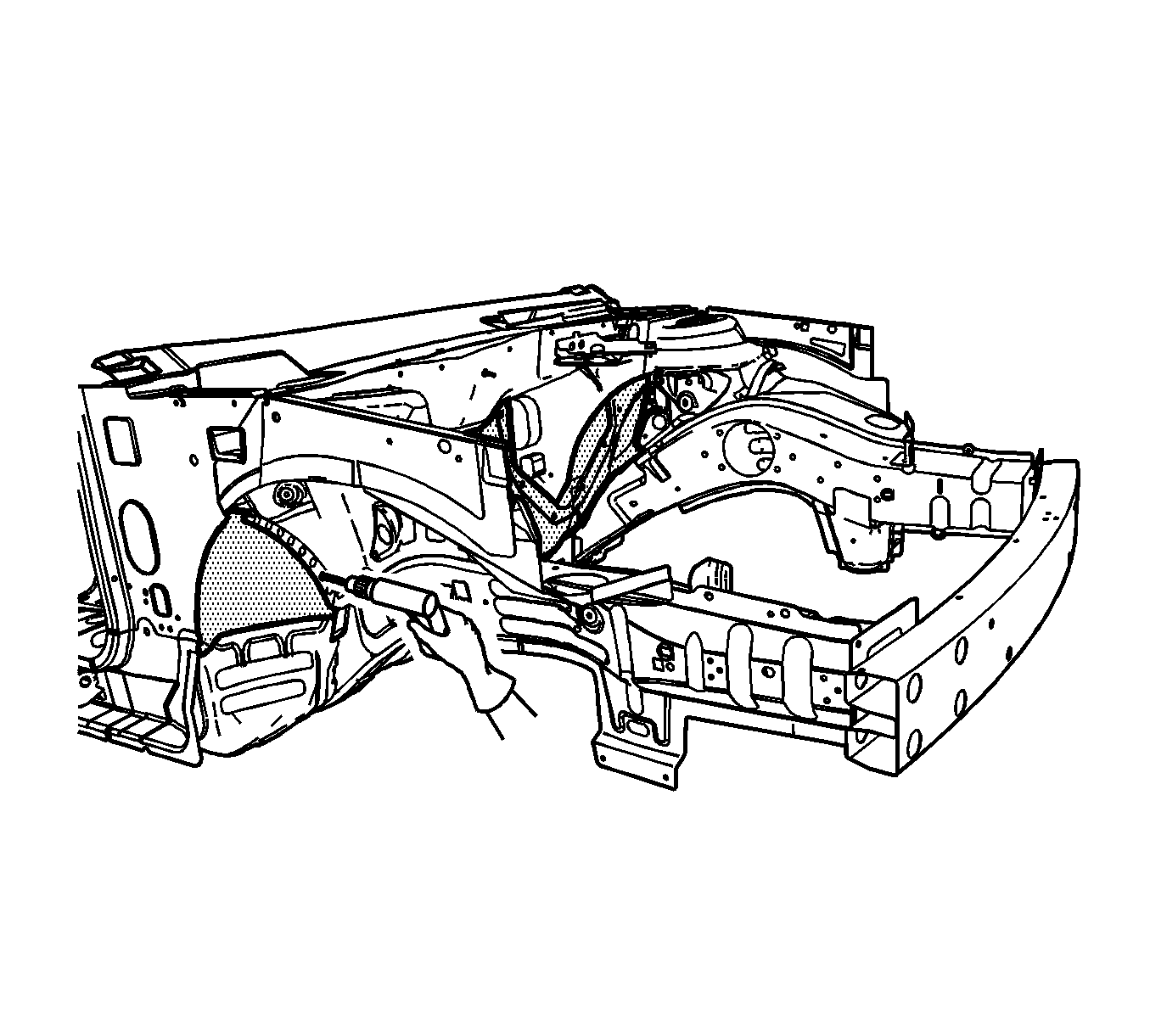

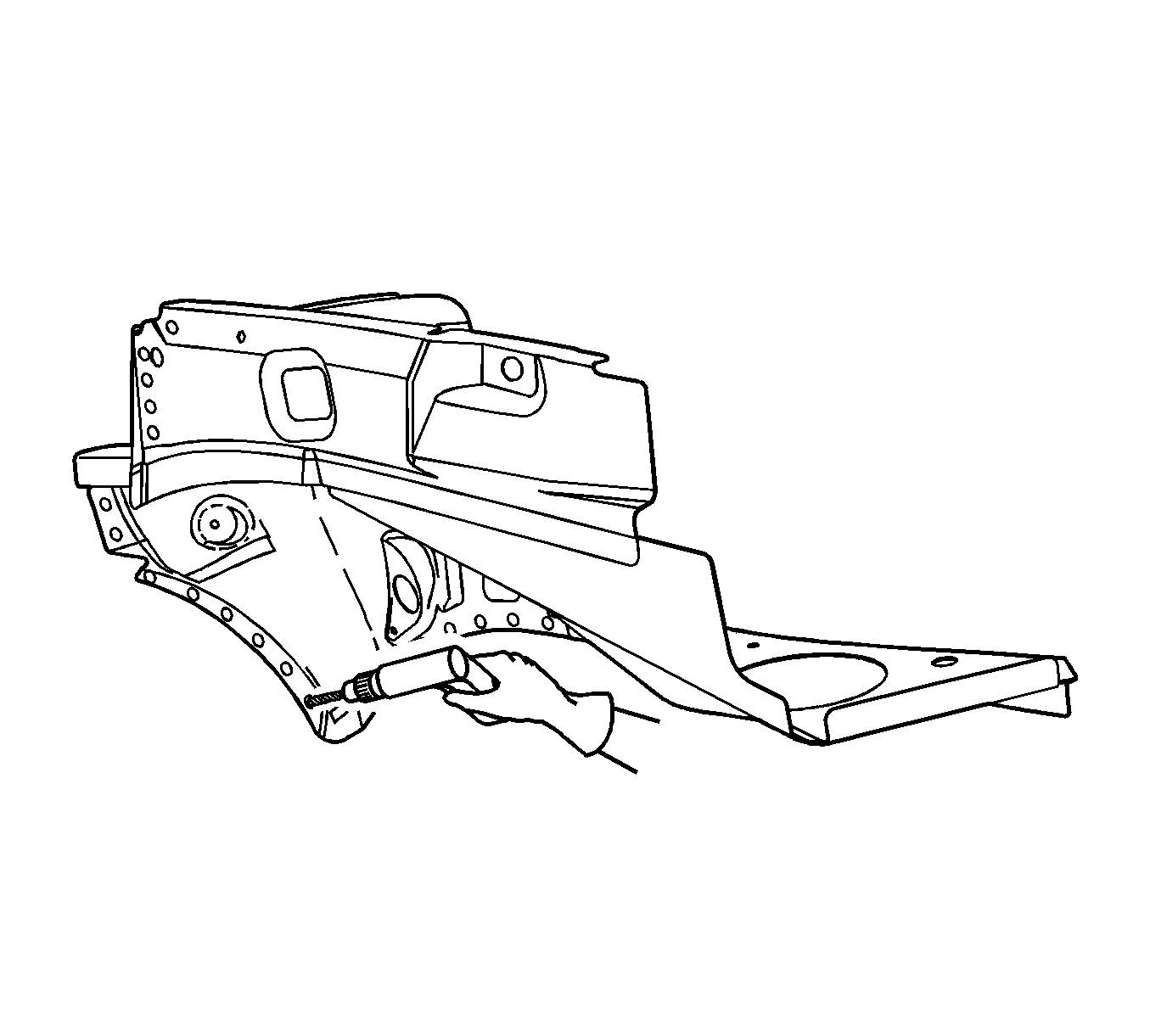
Important: If the location of the original plug weld holes cannot be determined, space the plug weld holes every 40 mm (1.5 in) apart.
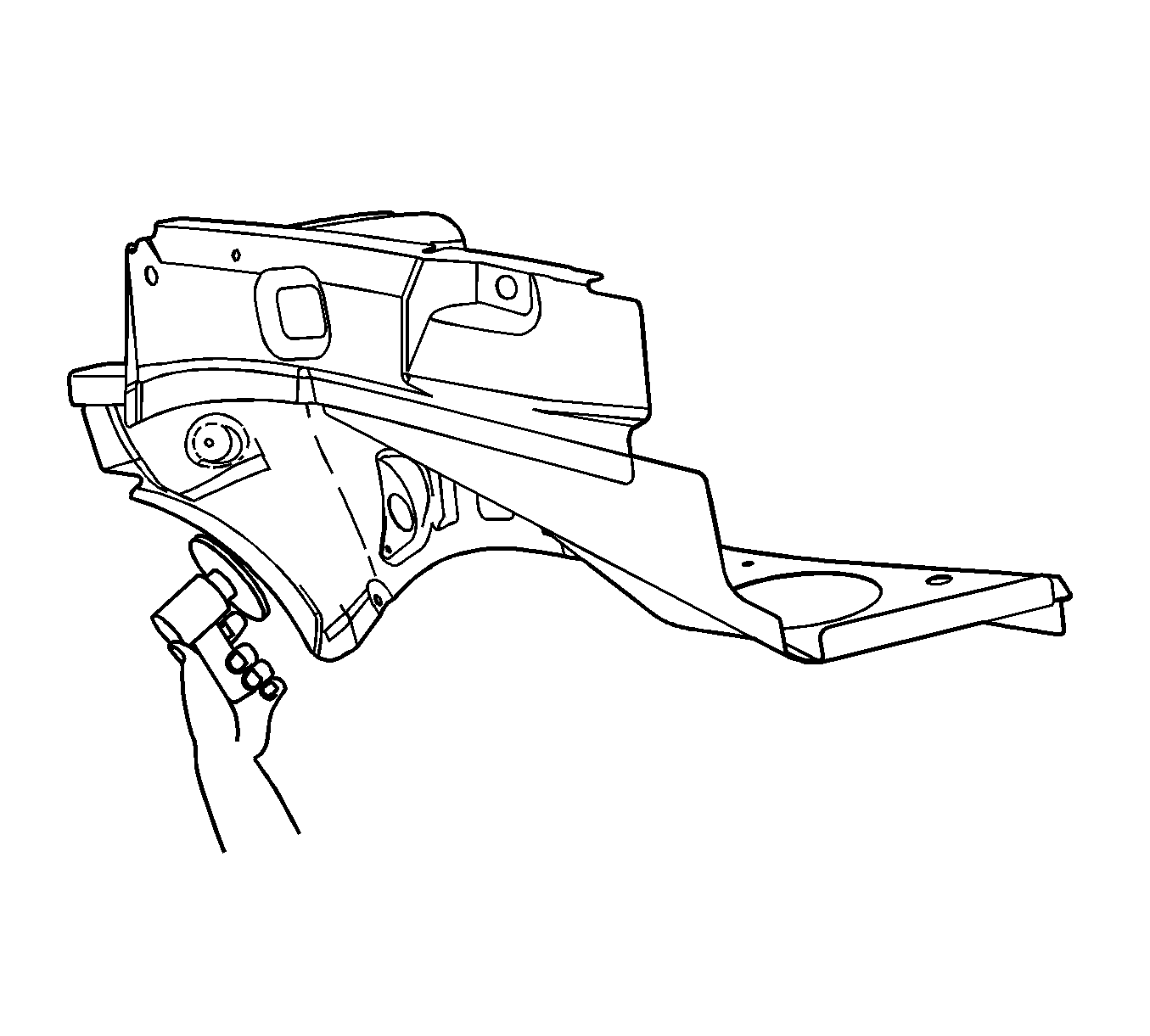
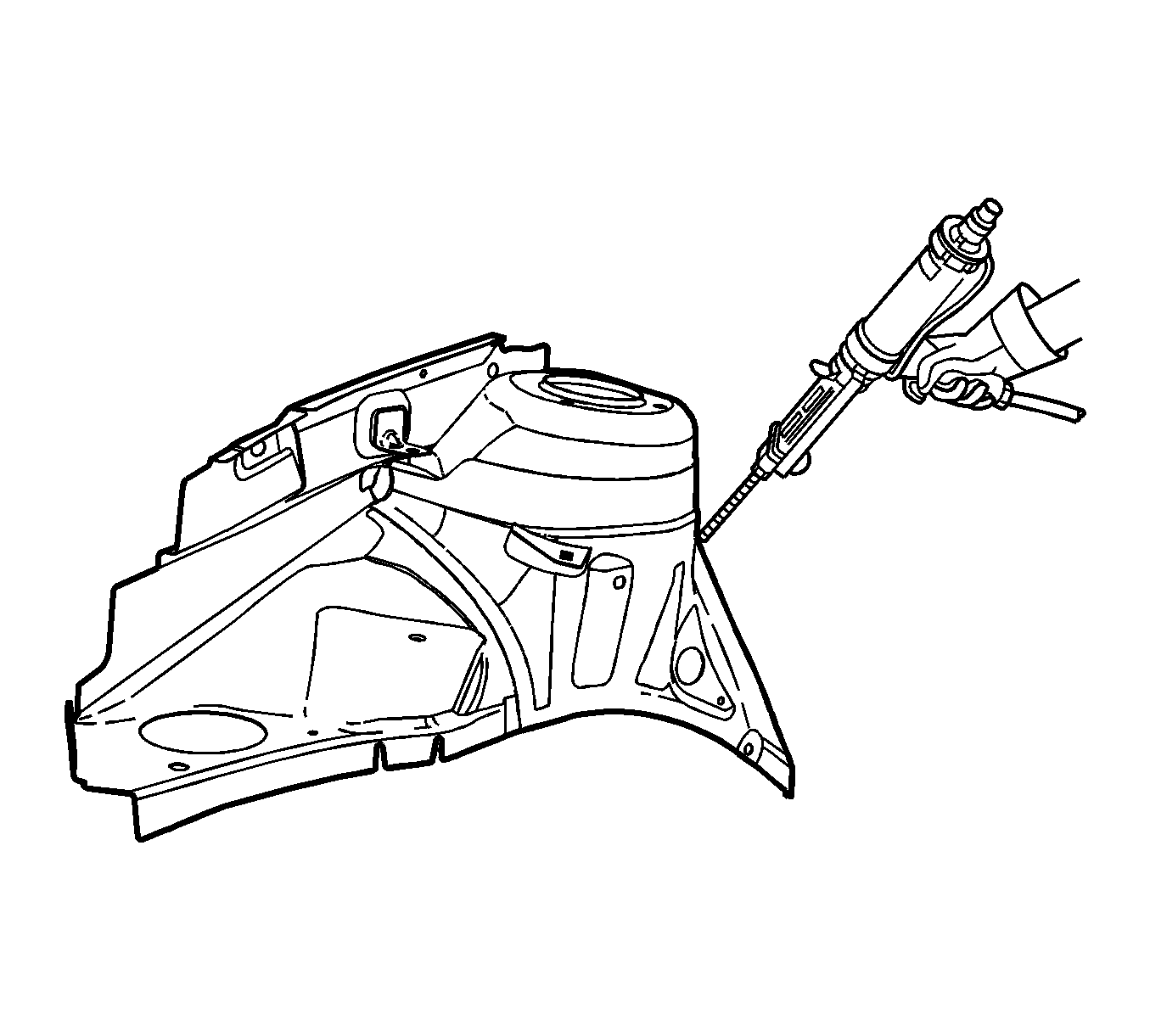
Important: The adhesive has a 40-50 minute working time. Do NOT allow the adhesive to cure prior to installing the service wheelhouse.



Important: Do NOT pull the wheelhouse off of the dash after adhesion. To align the parts, slide the wheelhouse against the front of the dash.

Important: Verify proper positioning of the service wheelhouse prior to riveting and welding.
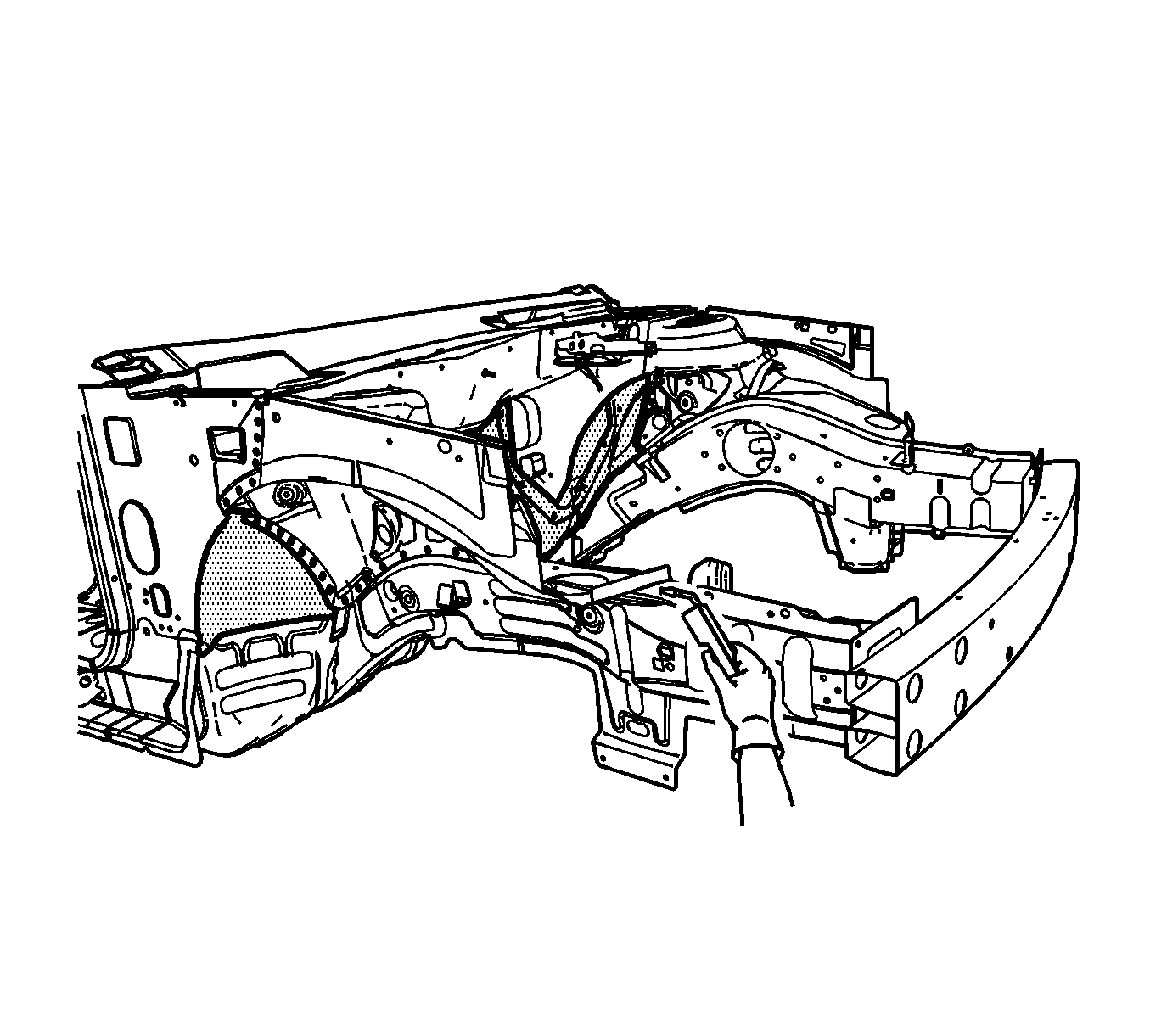
Hinge Pillar Body Replacement - Front Inner (Laminated Steel Dash)
Removal Procedure
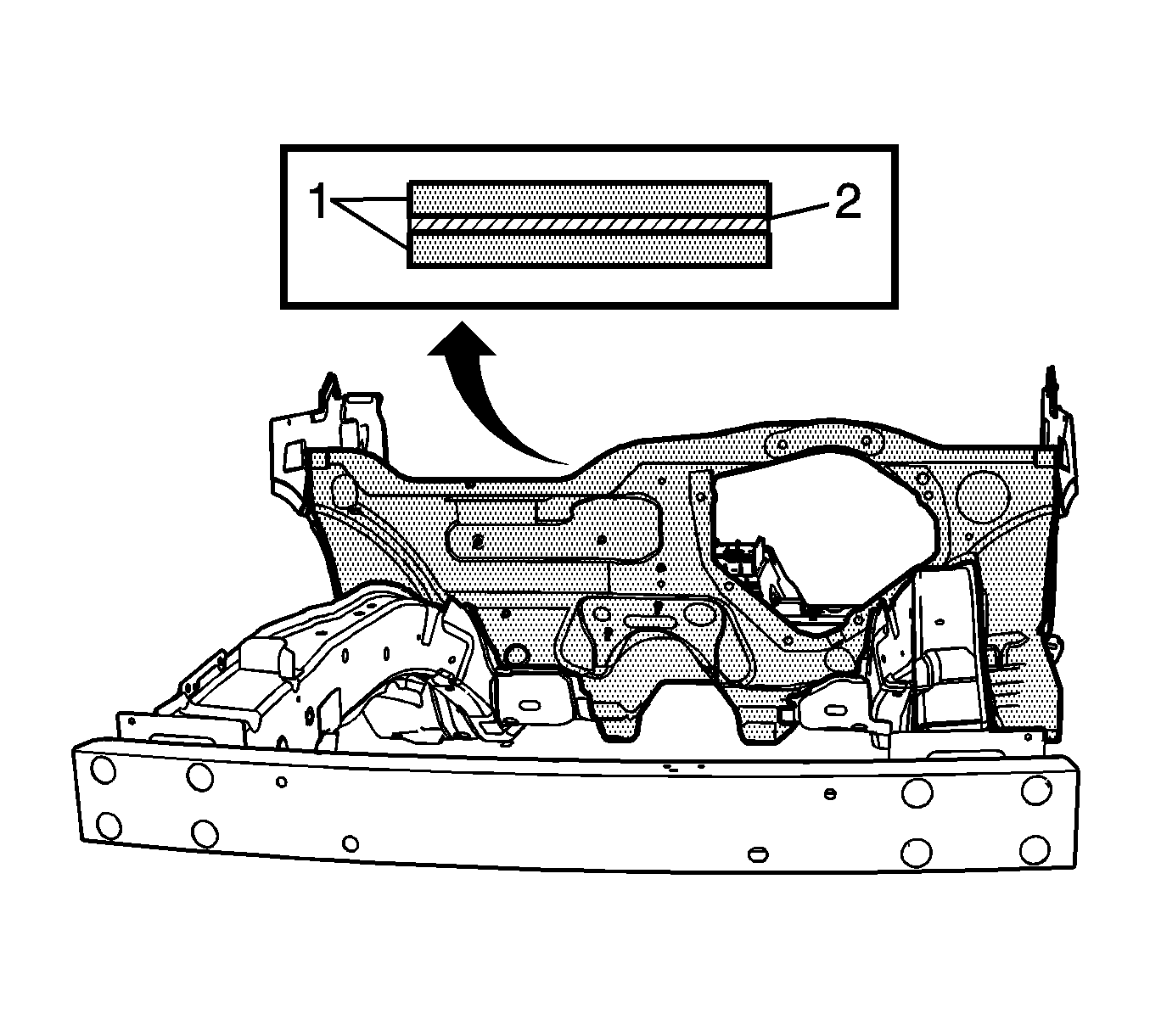
Important: Failure to follow this procedure will compromise the structural integrity of the vehicle.
The front of the dash panel and plenum lower are formed from laminated steel. This steel is constructed by bonding 2 pieces of cold rolled steel with a viscosities layer of adhesive. MIG welding laminated steel does not meet GM Corporate standards for structural integrity. As an alternative, all factory welds may be replaced by using the rivet and adhesive bond method described in the installation portion of this procedure. The rivet and adhesive bond method must only be used in the areas described in this procedure.
- Disable the SIR system. Refer to SIR Disabling and Enabling Zones.
- Disconnect the negative battery cable. Refer to Battery Negative Cable Disconnect/Connect Procedure.
- Remove the sealers and anti-corrosion materials from the repair area, as necessary. Refer to Anti--Corrosion Treatment and Repair.
- Visually inspect the damaged area. Repair as much of the damage as possible. Refer to Dimensions--Body .
- Using an 8 mm (5/16 in) spot weld remover, locate and drill out the factory welds on the weld flange connecting the front inner hinge pillar to the dash panel.
- Locate and drill out all remaining factory welds.
- Remove the front inner hinge pillar from the vehicle.
Caution: Refer to Approved Equipment for Collision Repair Caution.
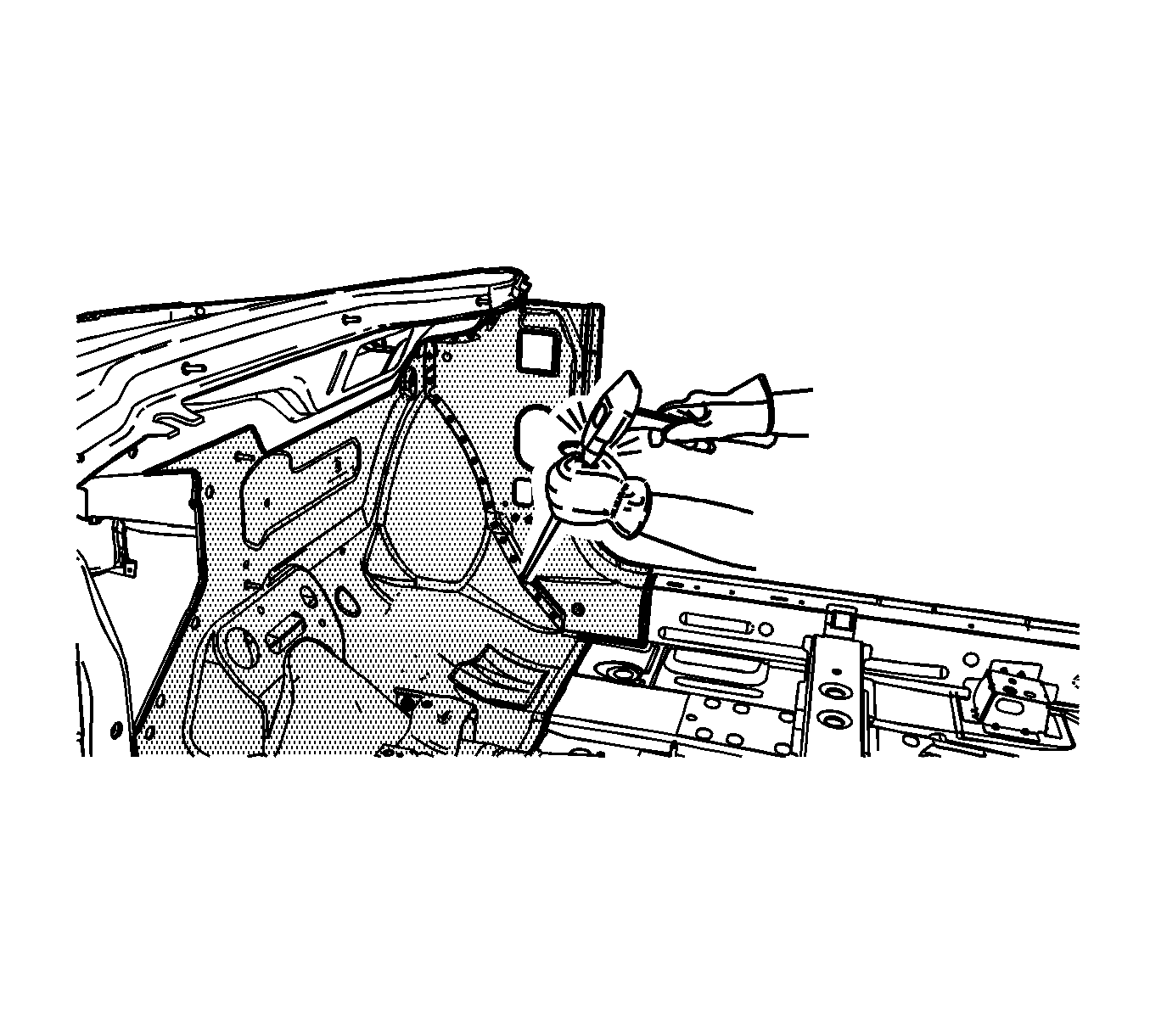
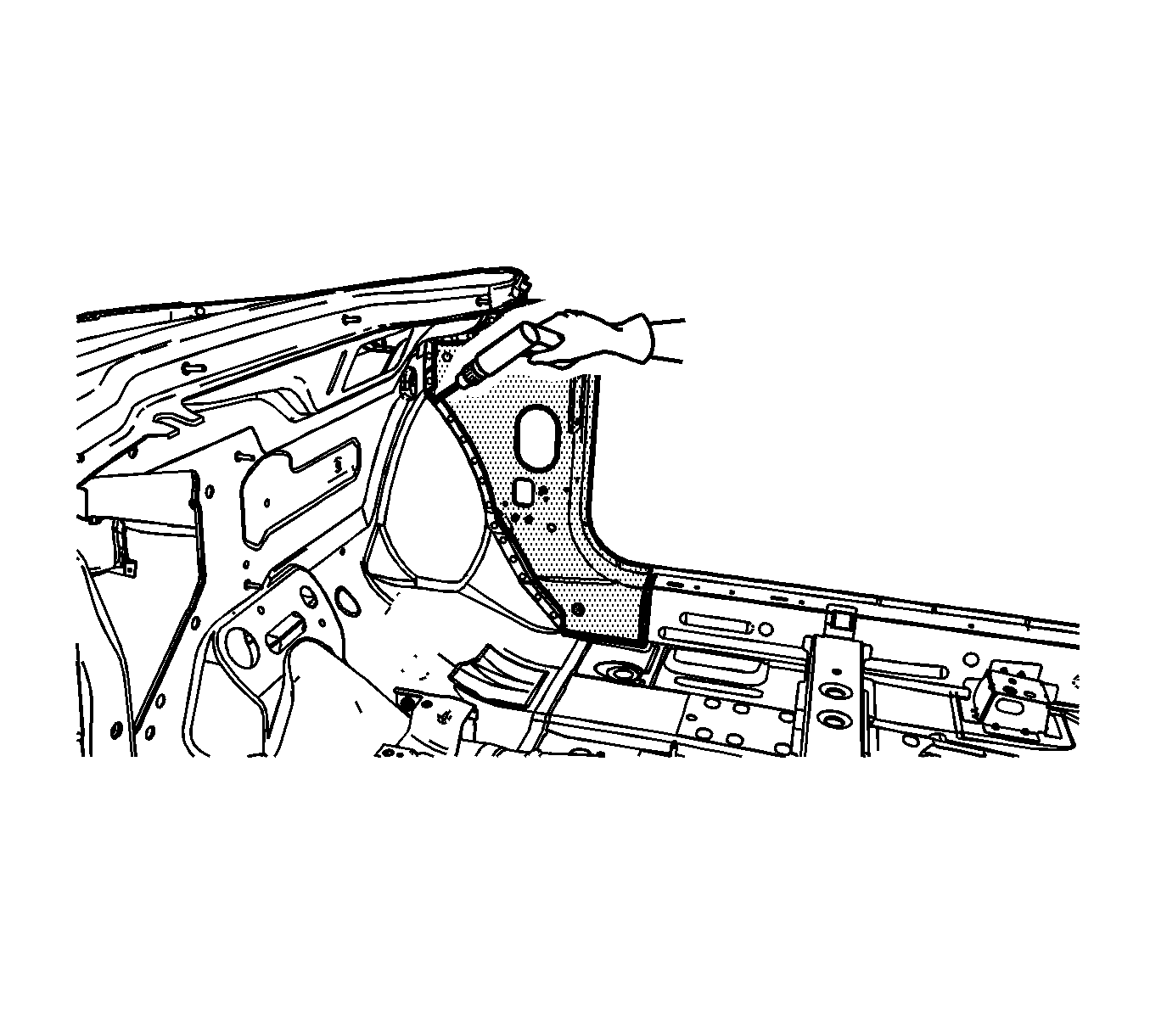
Important: Note the number and location of welds for installation of the front inner hinge pillar.
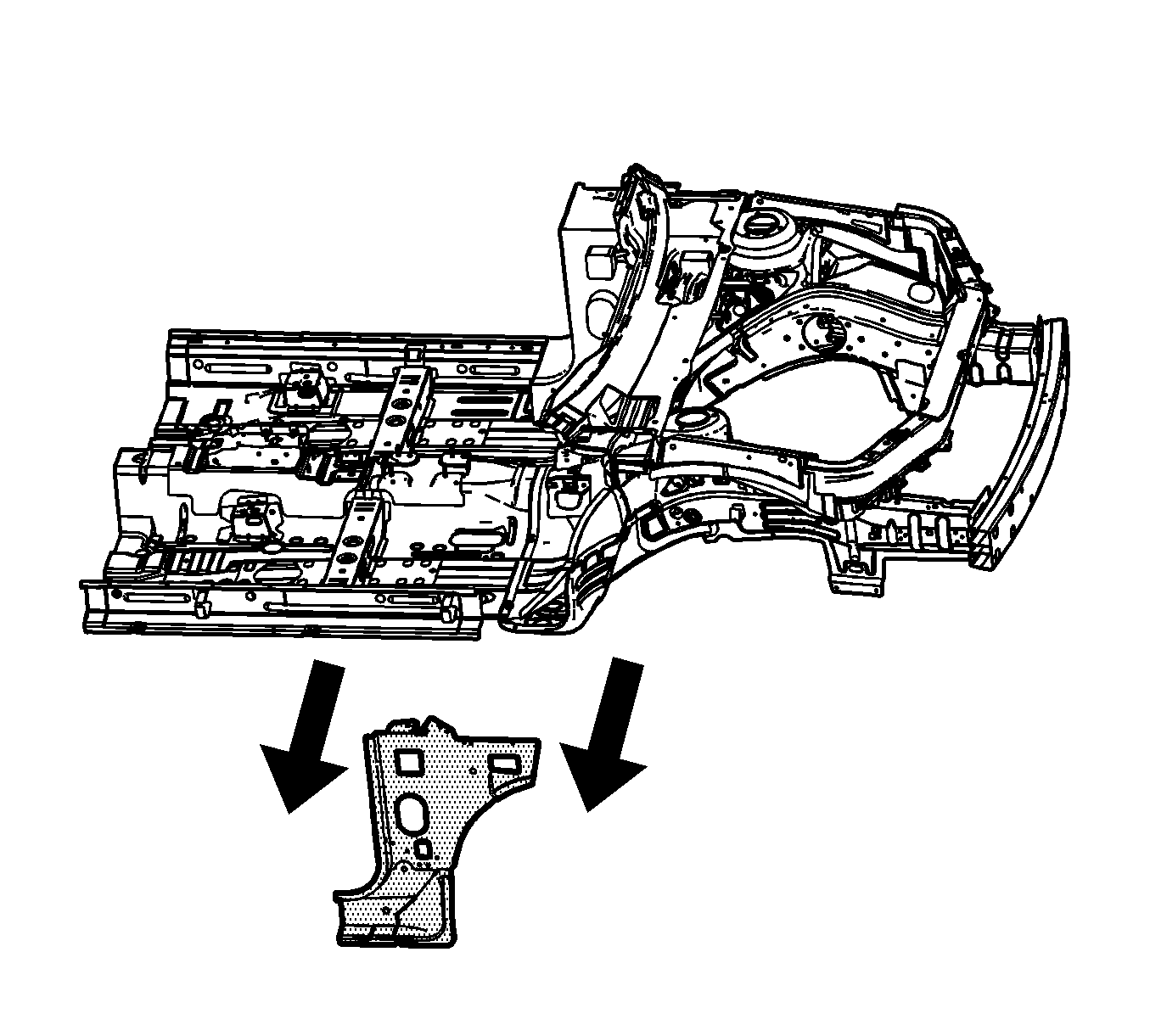
Installation Procedure
- Position the service front inner hinge pillar in the vehicle using 3-dimensional measuring equipment. Clamp the front inner hinge pillar in place.
- Using a 7 mm (17/64 in) bit, drill the rivet attachment holes into the service hinge pillar through the dash and the lower rail extension in the locations as noted from the factory front inner hinge pillar.
- Remove the service front inner hinge pillar.
- Drill 8 mm (5/16 in) plug weld holes as necessary in the locations noted from the original assembly.
- Prepare the MIG weld mating surfaces as necessary.
- Apply 3M Weld-Thru Coating, P/N 05916, or equivalent, to all MIG weld mating surfaces.
- Prepare the bonding mating areas by grinding to bare steel the surface of the dash panel and the service front inner hinge pillar flanges.
- Apply a 3-6 mm (1/8-1/4 in) bead of metal panel bonding adhesive, P/N 12378567 (Canadian P/N 88901675), or equivalent, to the mating surfaces of the dash panel and the front inner hinge pillar service panel.
- Using a small acid brush, spread a coating of adhesive on the mating surfaces. Cover all of the bare metal to ensure corrosion protection.
- Position the service front inner hinge pillar to the vehicle using 3-dimensional measuring equipment. Clamp the front inner hinge pillar in place.
- Install the 14 mm (17/32 in) long rivets to the front of the dash flange panel.
- Remove the excess adhesive from the front inner hinge pillar bond rivet area.
- Plug weld accordingly.
- Clean and prepare all of the welded surfaces.
- Apply the sealers and anti-corrosion materials to the repair area, as necessary. Refer to Anti--Corrosion Treatment and Repair.
- Paint the repaired area. Refer to Basecoat/Clearcoat Paint Systems.
- Install all related panels and components.
- Connect the negative battery cable. Refer to Battery Negative Cable Disconnect/Connect Procedure.
- Enable the SIR system. Refer to SIR Disabling and Enabling Zones.
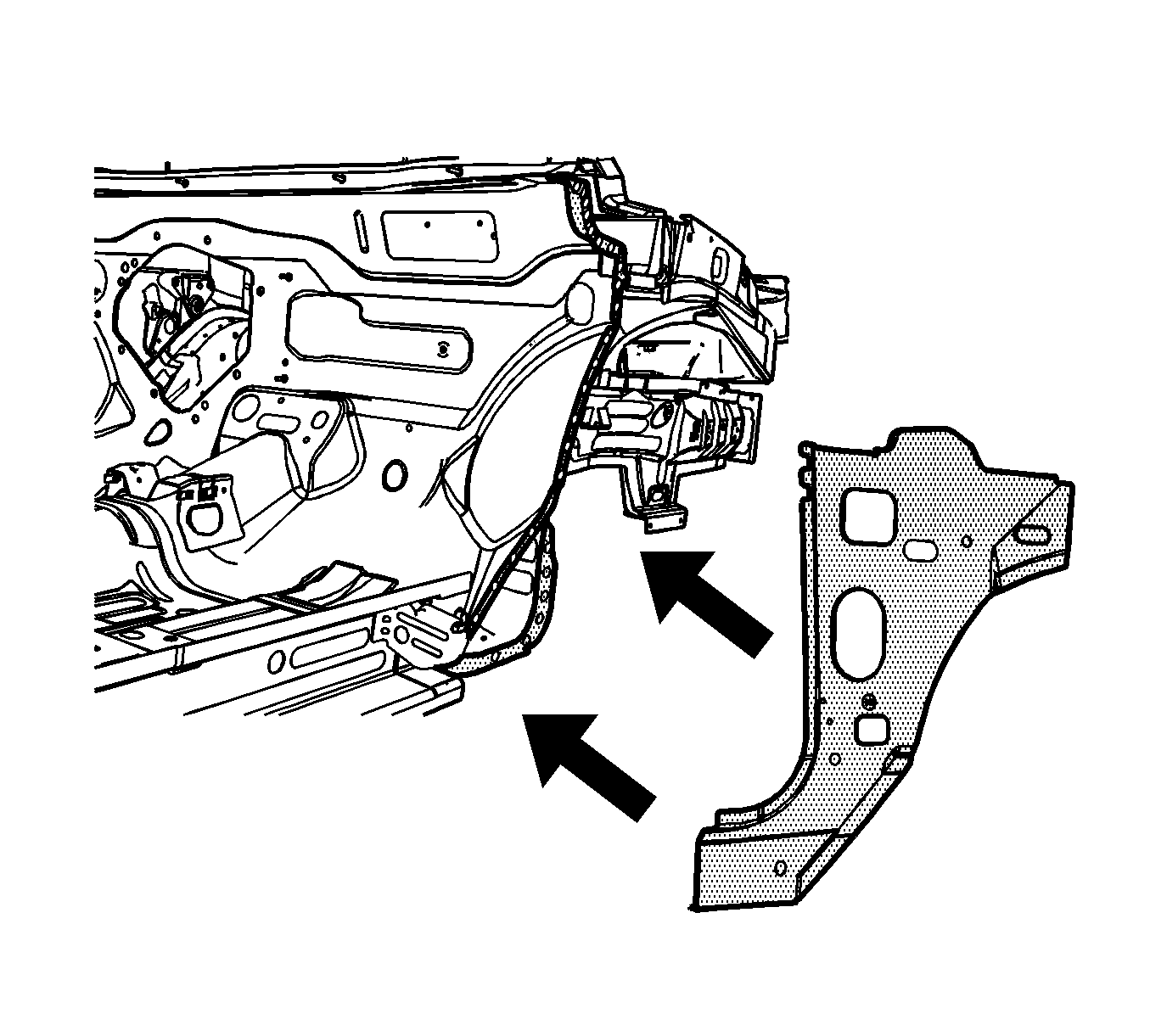
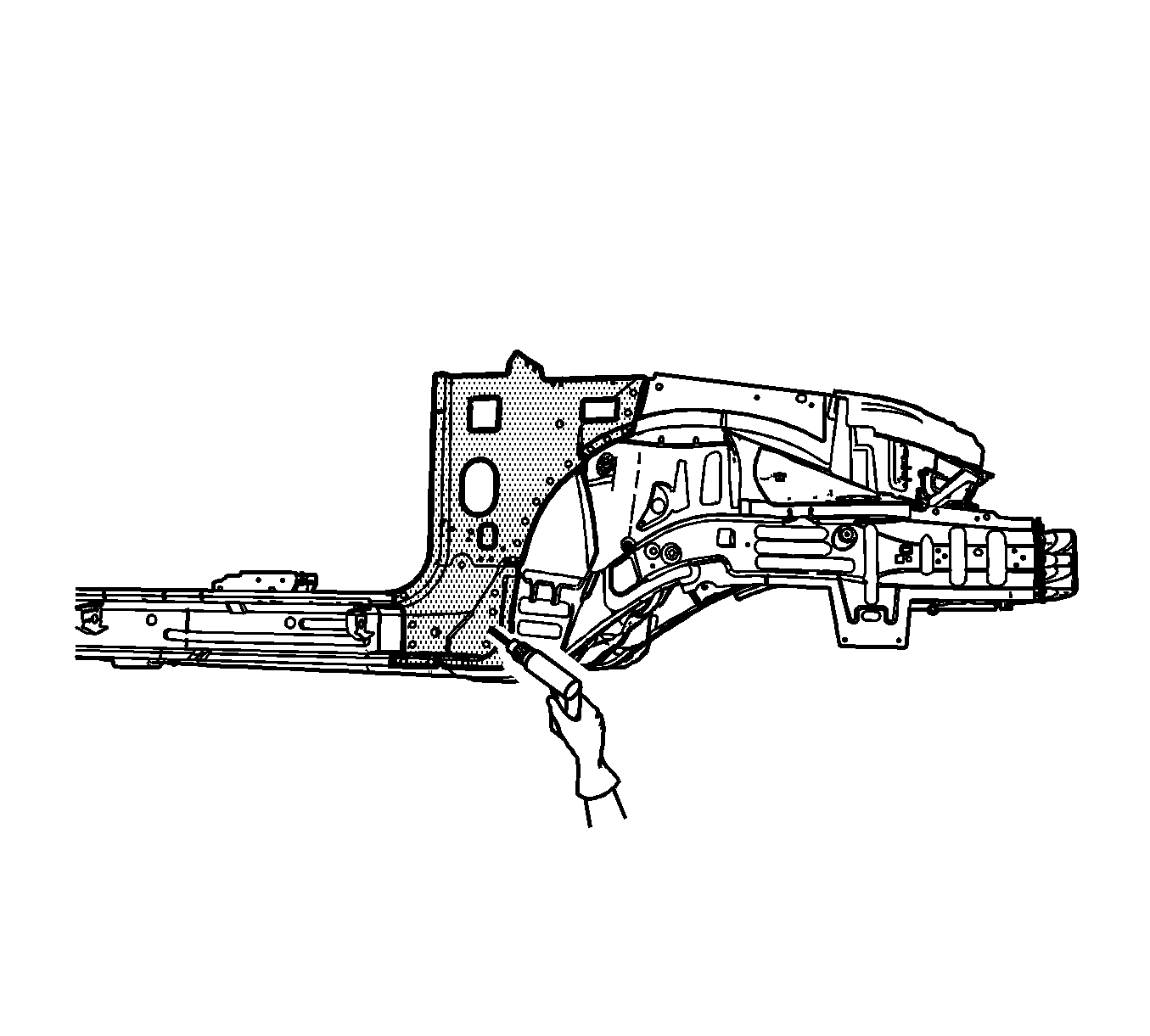
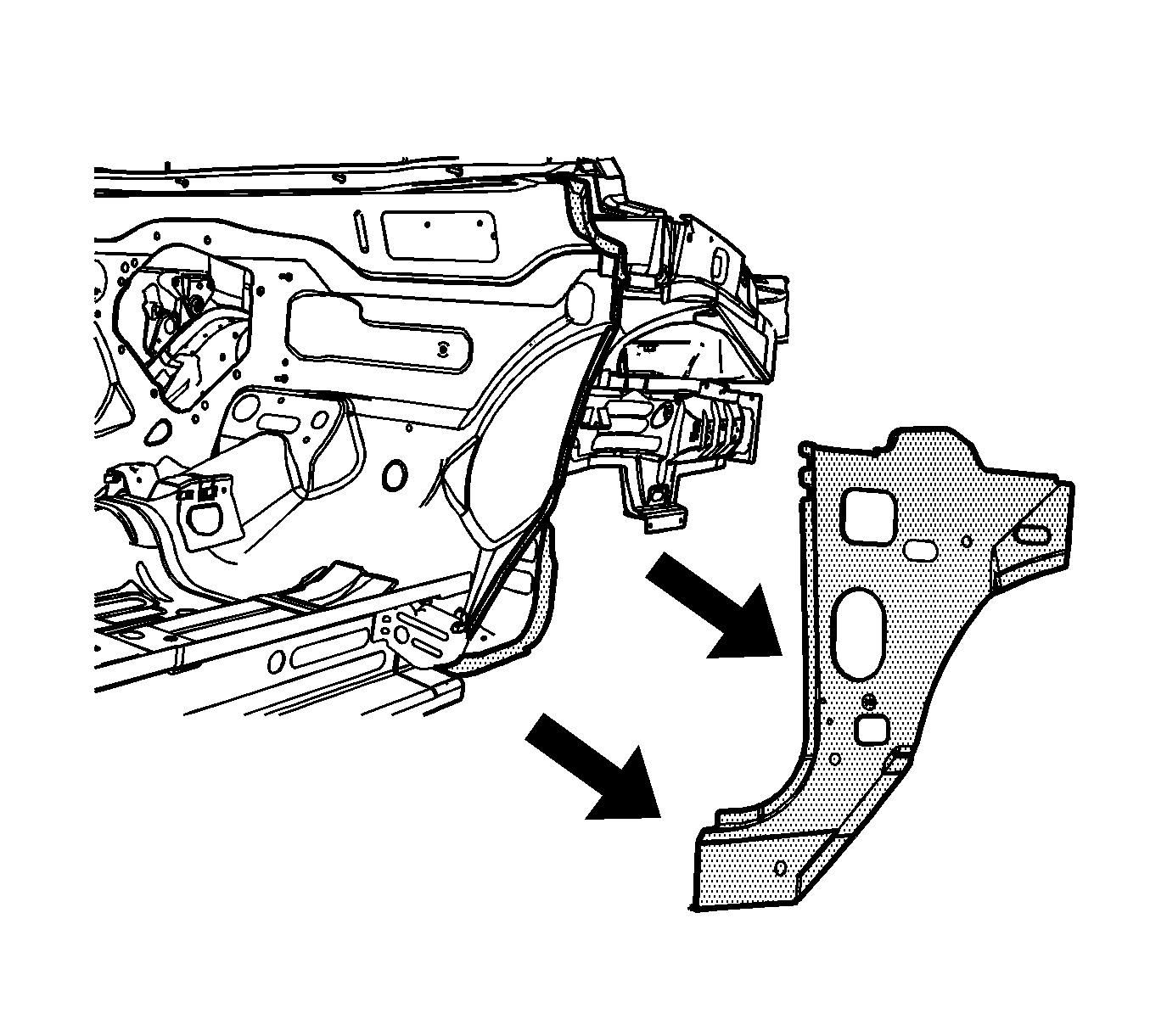
Important: If the location of the original plug weld holes can not be determined, space the plug weld holes every 40 mm (1 1/2 in) apart.
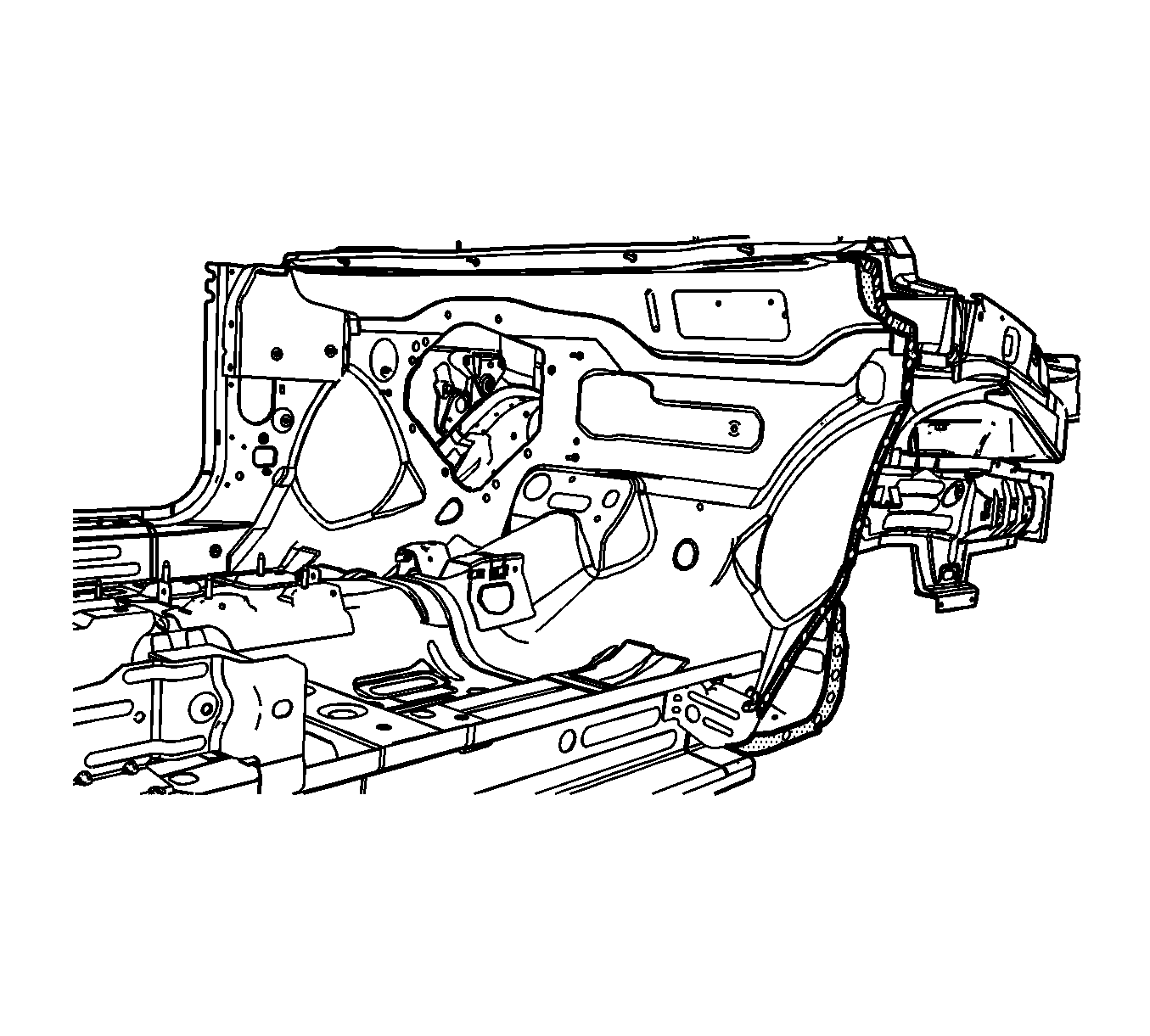
Important: Do not damage the corners or thin the metal during the grinding process.
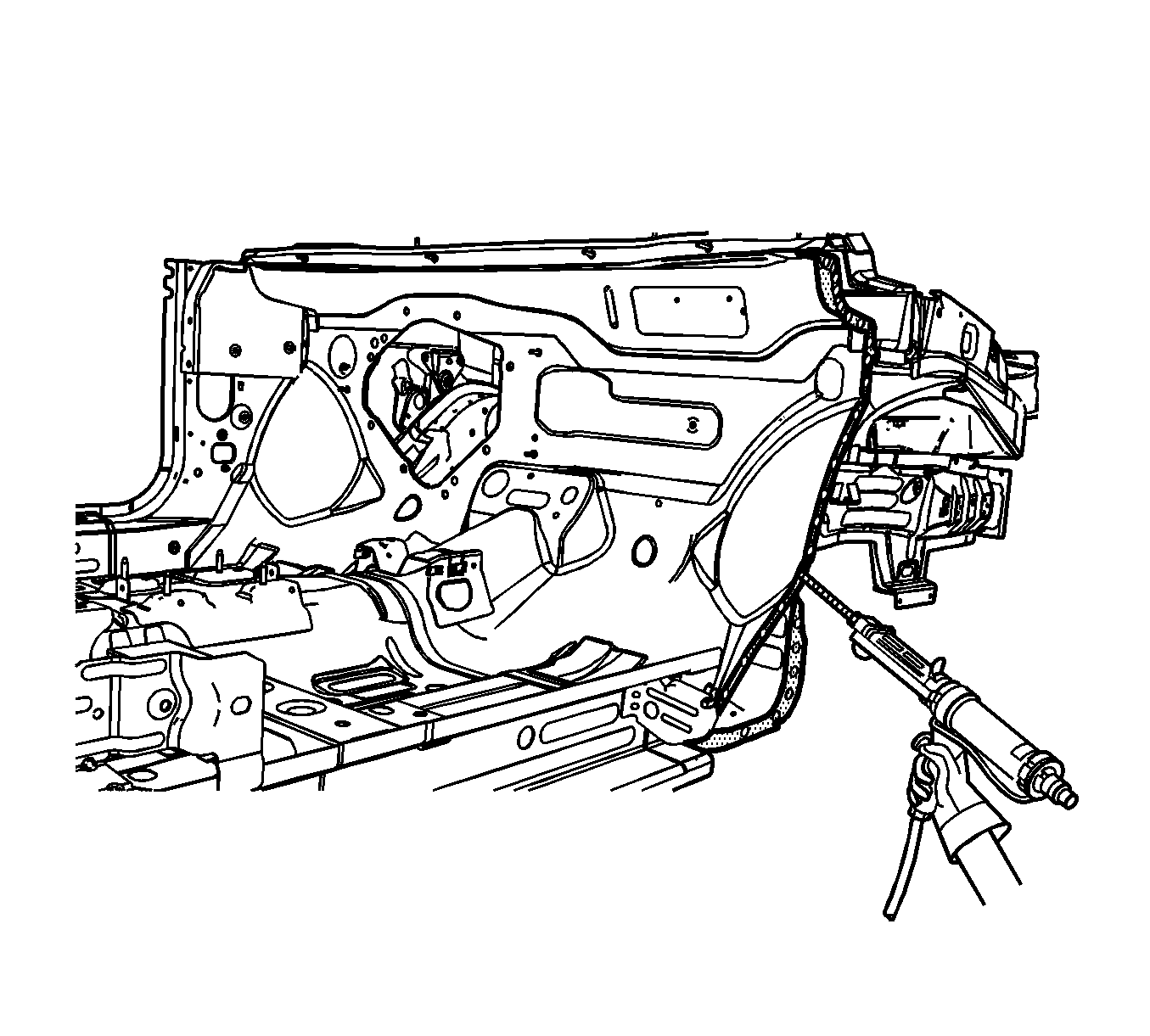
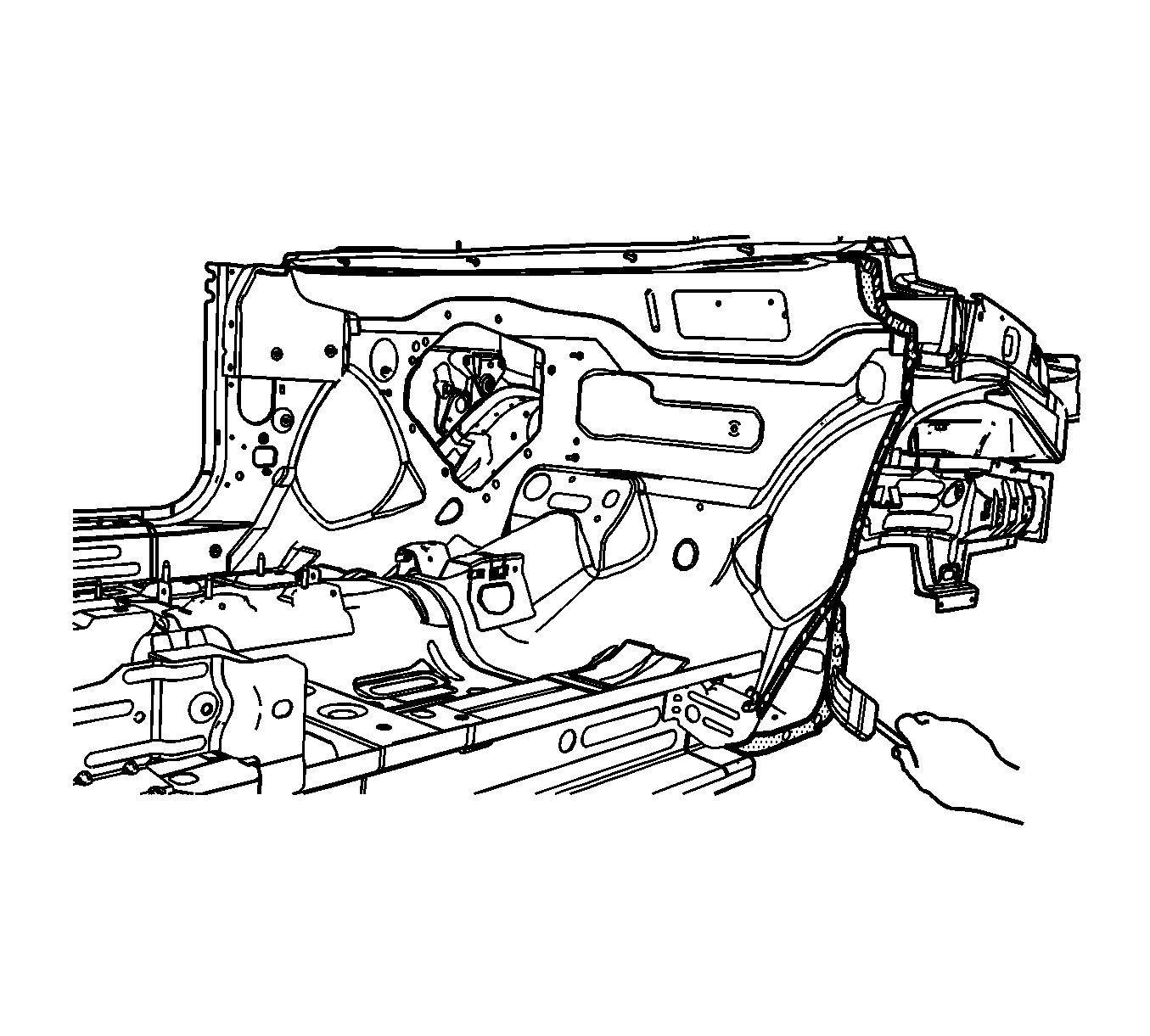
Important: Do not pull the front inner hinge pillar off of the dash after adhesion. To align the parts, slide the front inner hinge pillar against the dash panel.
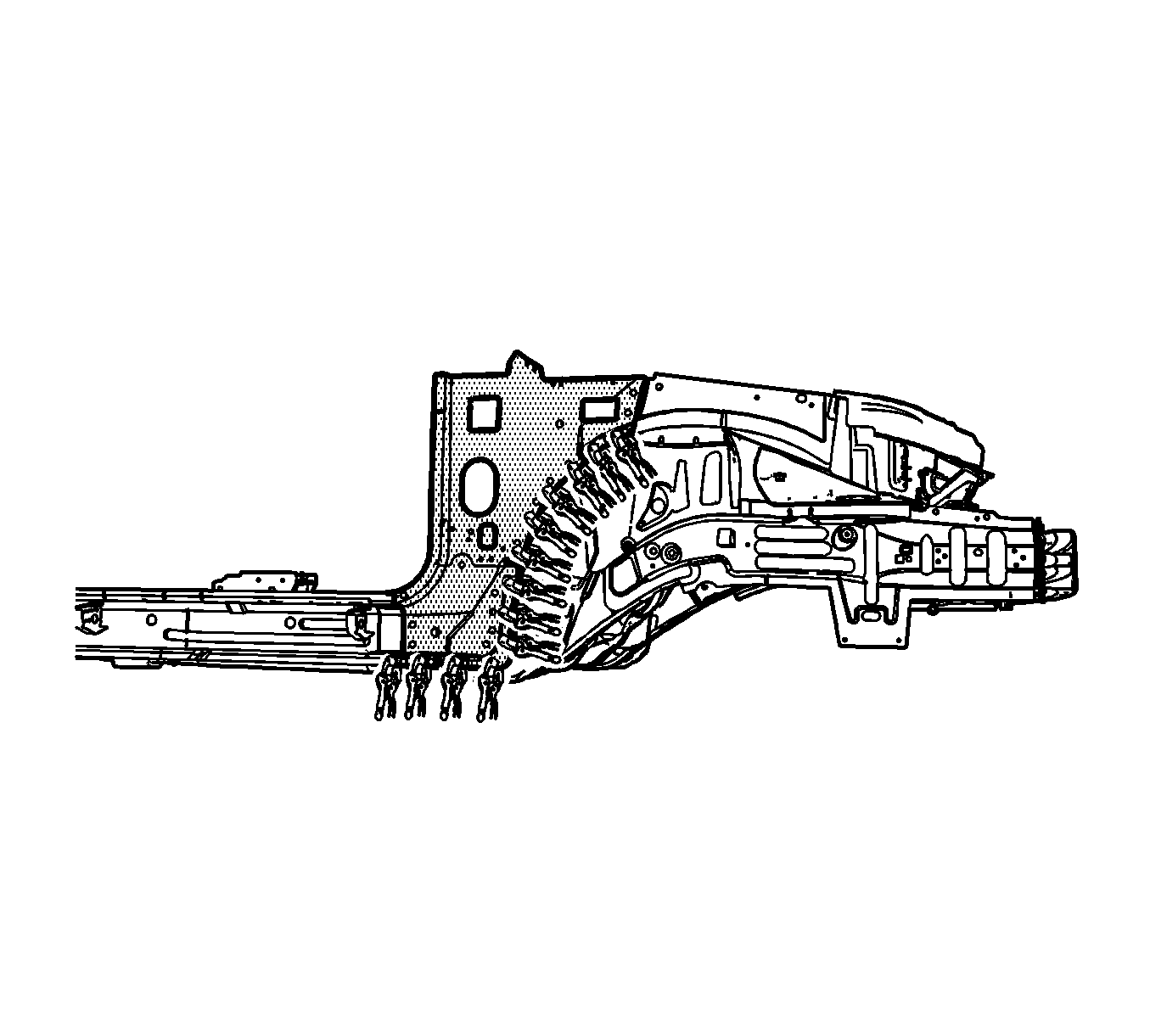
Important: Verify the proper positioning of the service front inner hinge pillar prior to riveting and welding.
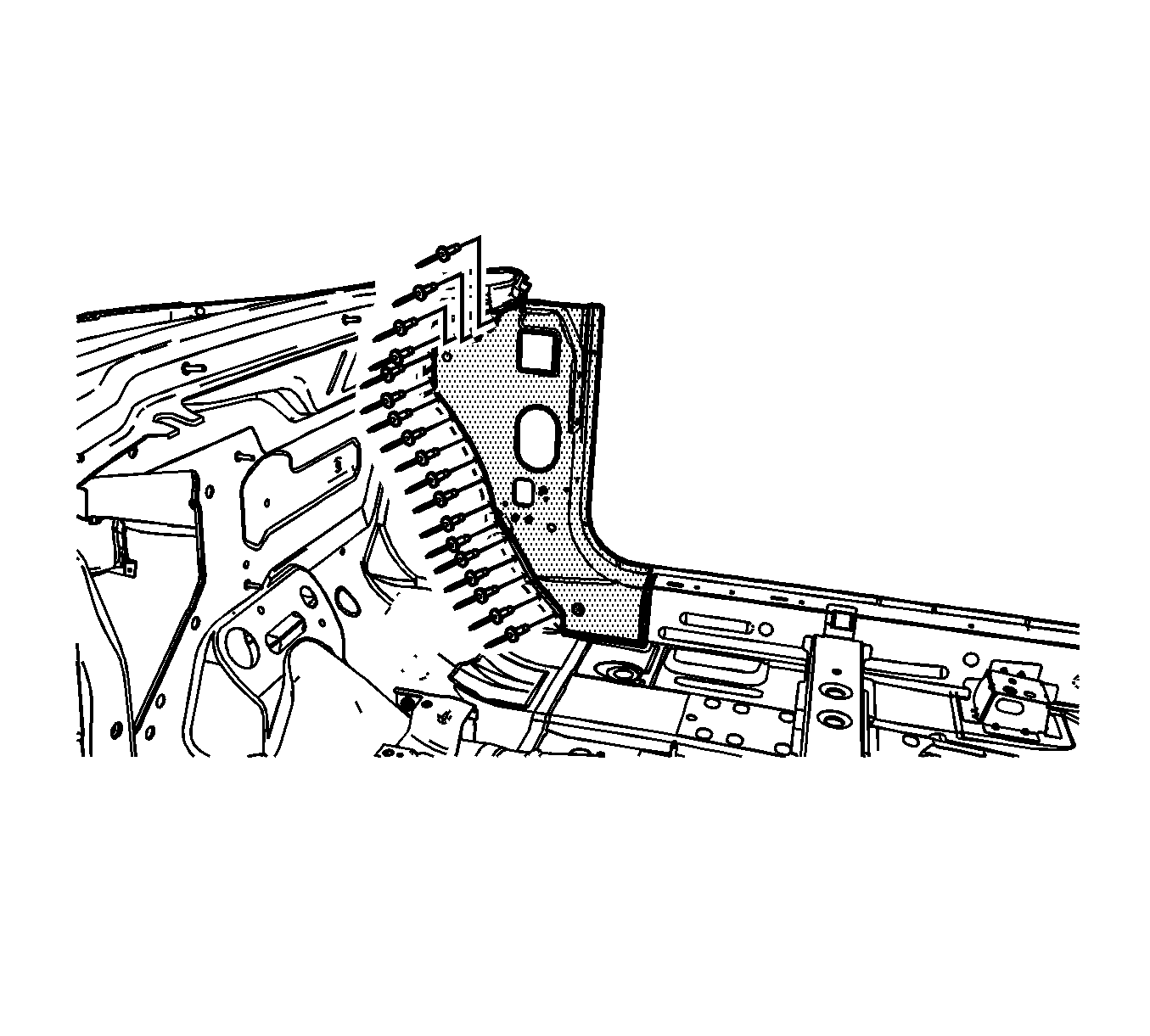
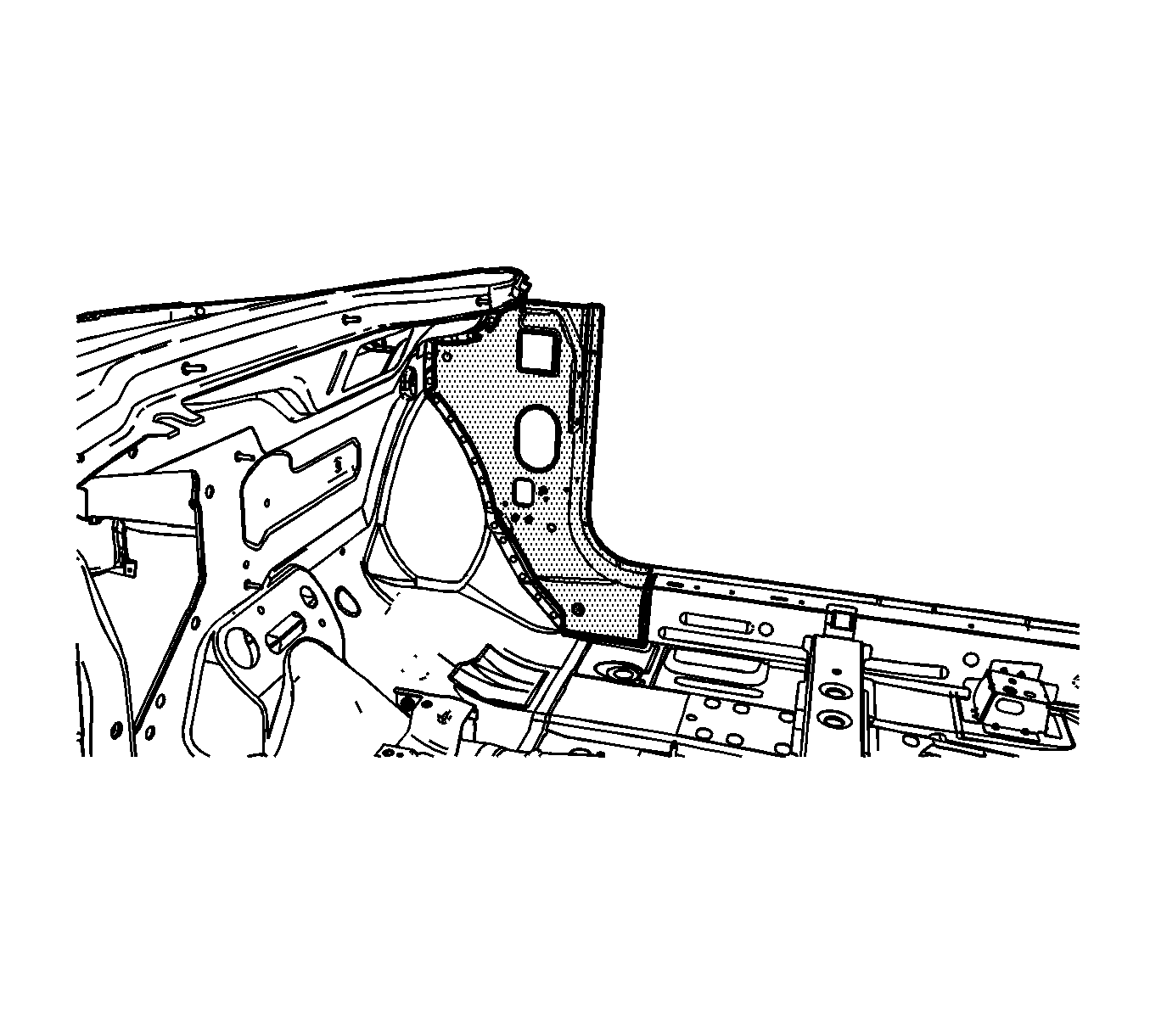
Parts Information
Important: These kits also contain an instruction sheet and rivets.
Part Number | Description |
|---|---|
15844075 | Rail Kit, Frt/Comt Si (RH) - All |
15844076 | Rail Kit, Frt/Comt Si (LH) - All |
15800730 | Panel Kit, Frt W/H (RH) - G6 |
15800731 | Panel Kit, Frt W/H (LH) - G6 |
15800736 | Panel Kit, Frt W/H (RH) - Malibu/Maxx |
15800737 | Panel Kit, Frt W/H (LH) - Malibu/Maxx |
15816777 | Panel Kit, Pnl H/Plr Inr (RH) - Malibu/Maxx |
15816778 | Panel Kit, Pnl H/Plr Inr (LH) - Malibu/Maxx |
15816775 | Panel Kit, Pnl H/Plr Inr (RH) - G6 |
15816776 | Panel Kit, Pnl H/Plr Inr (LH) - G6 |
